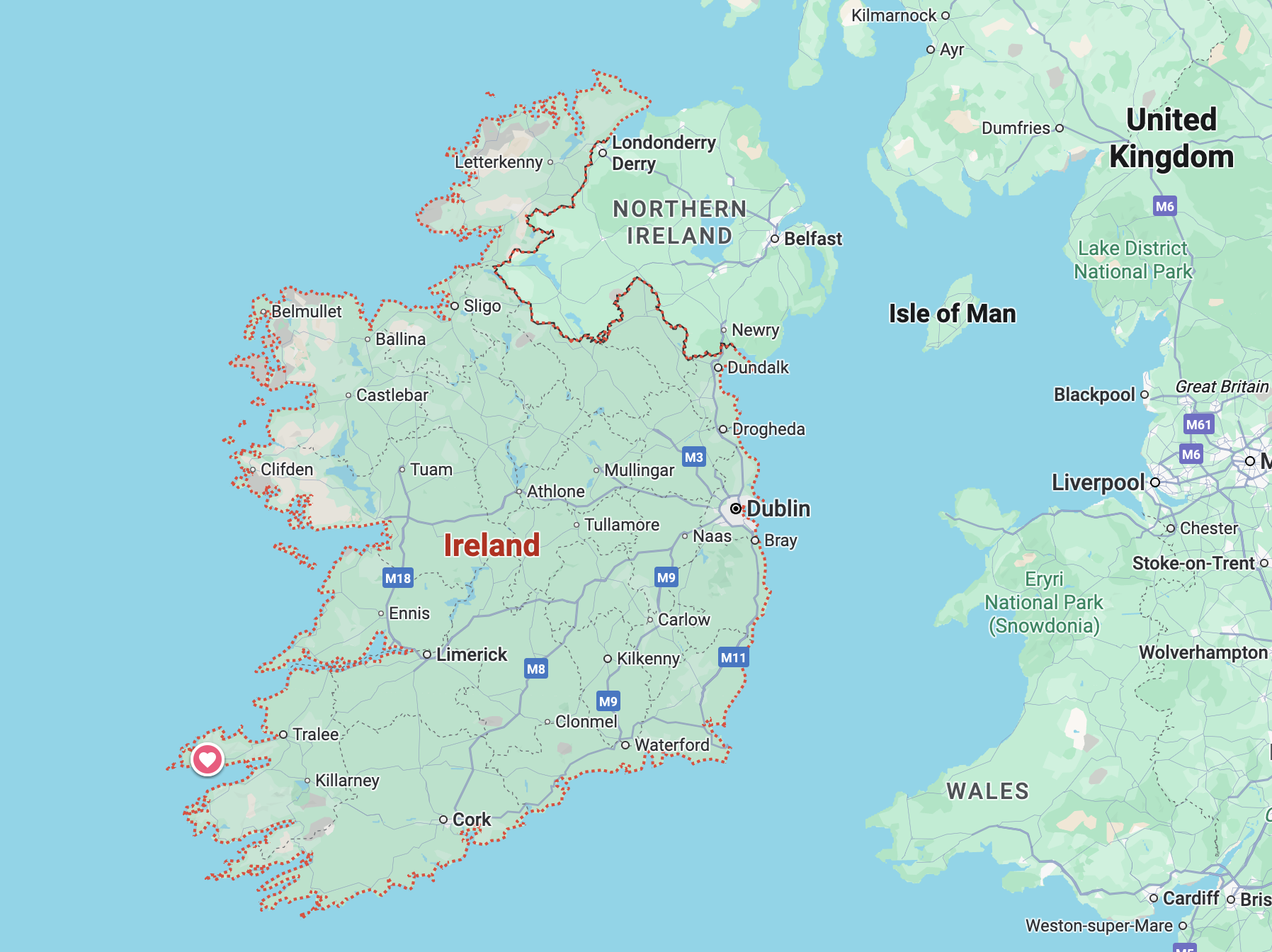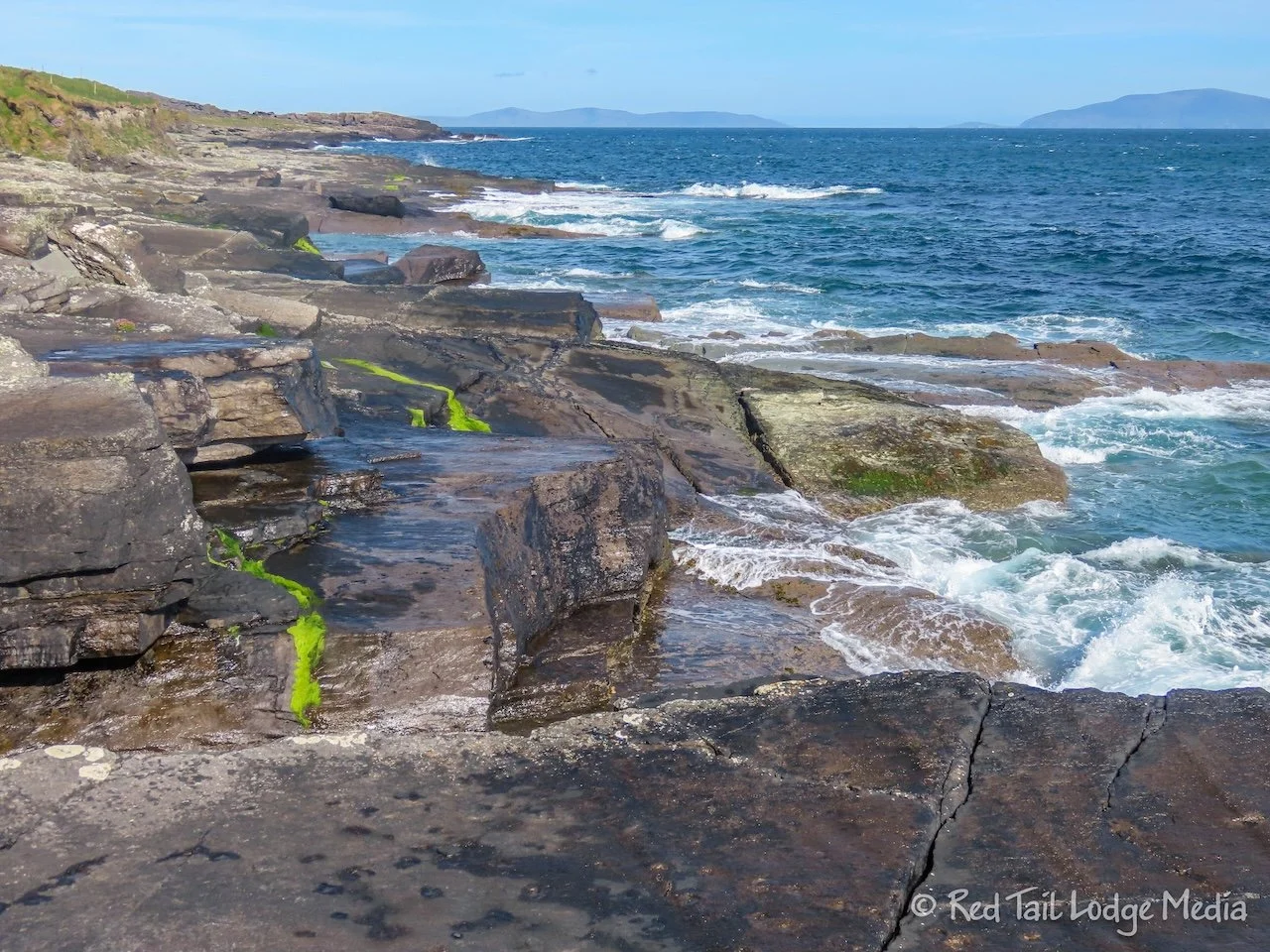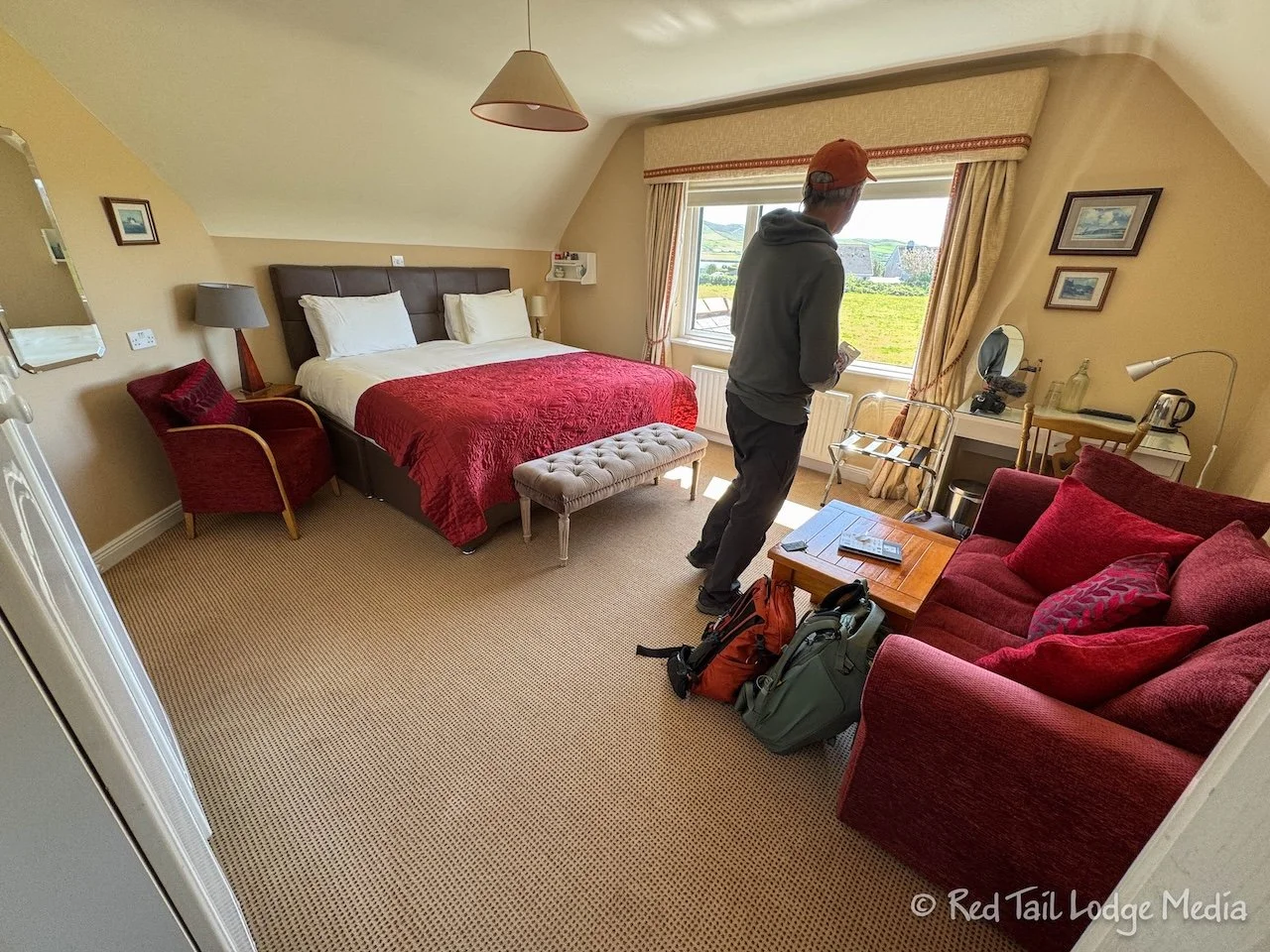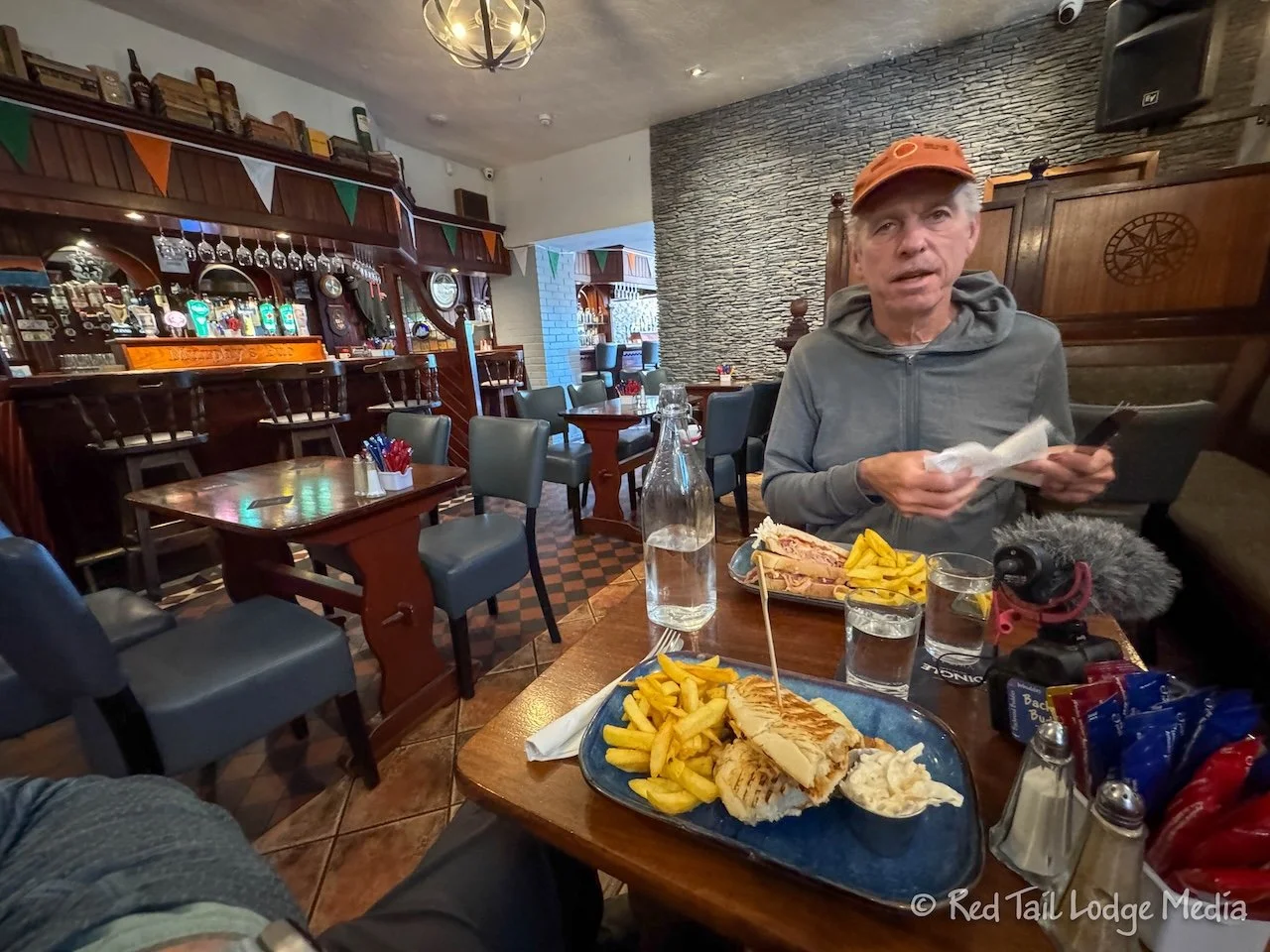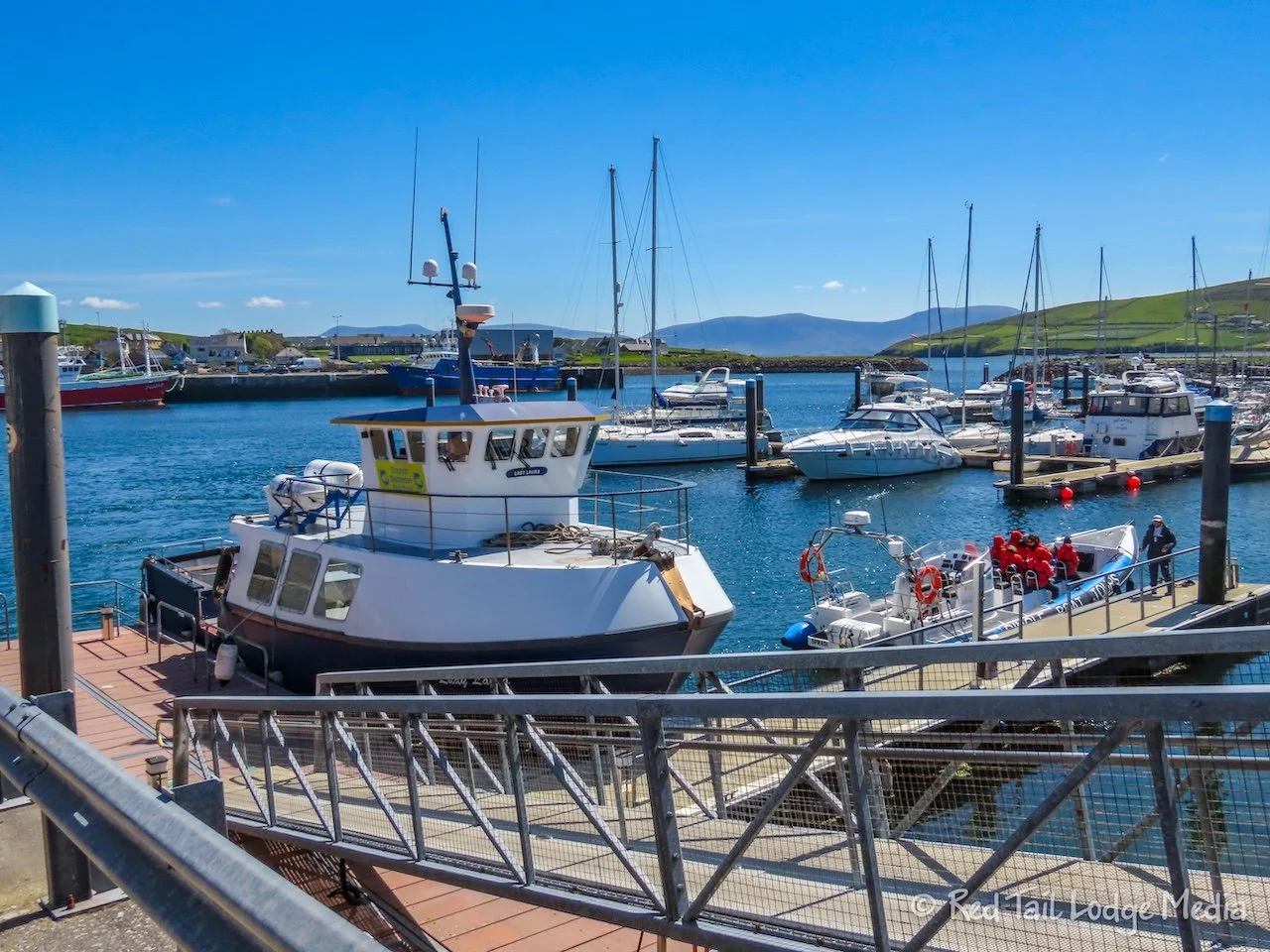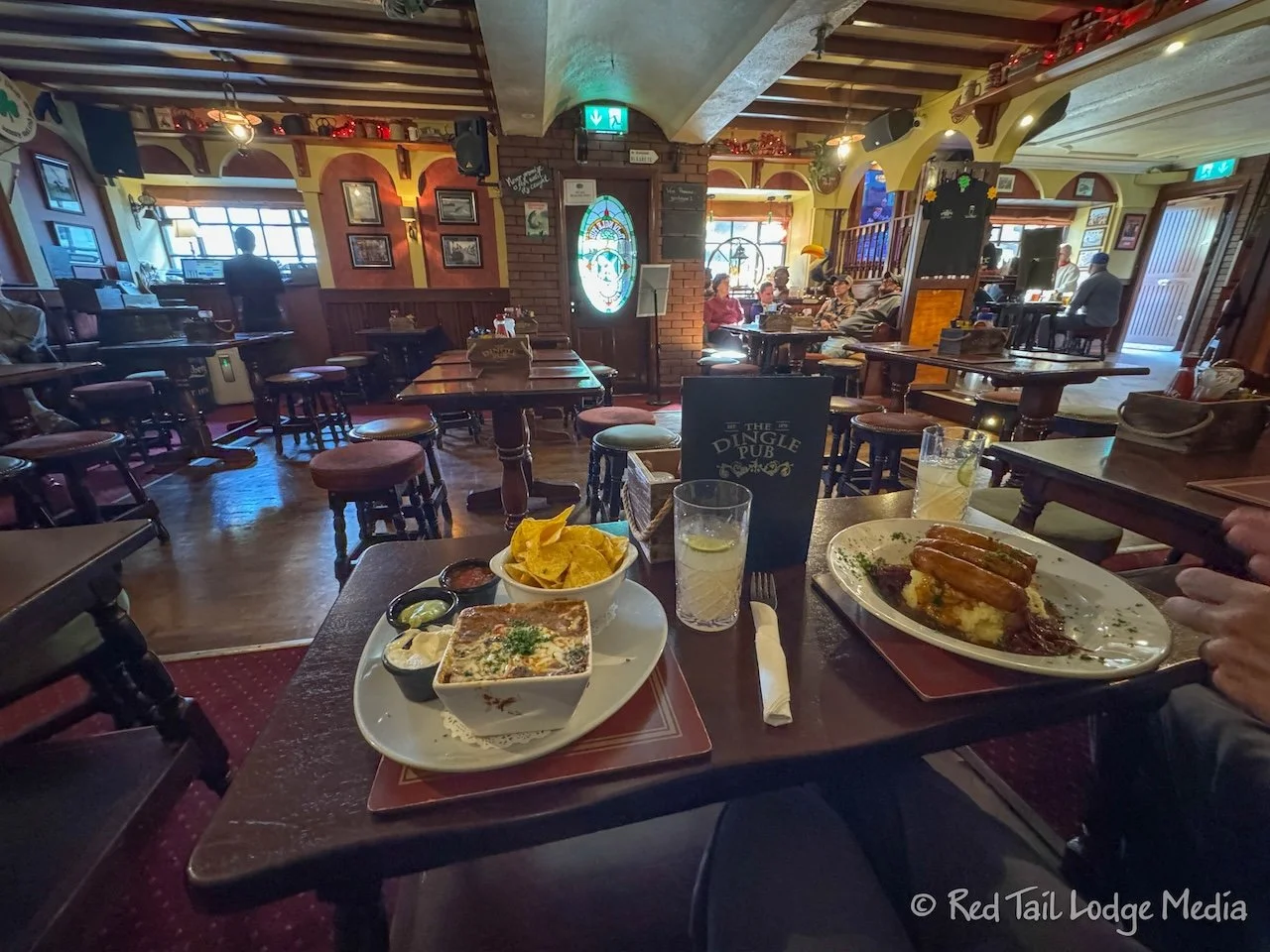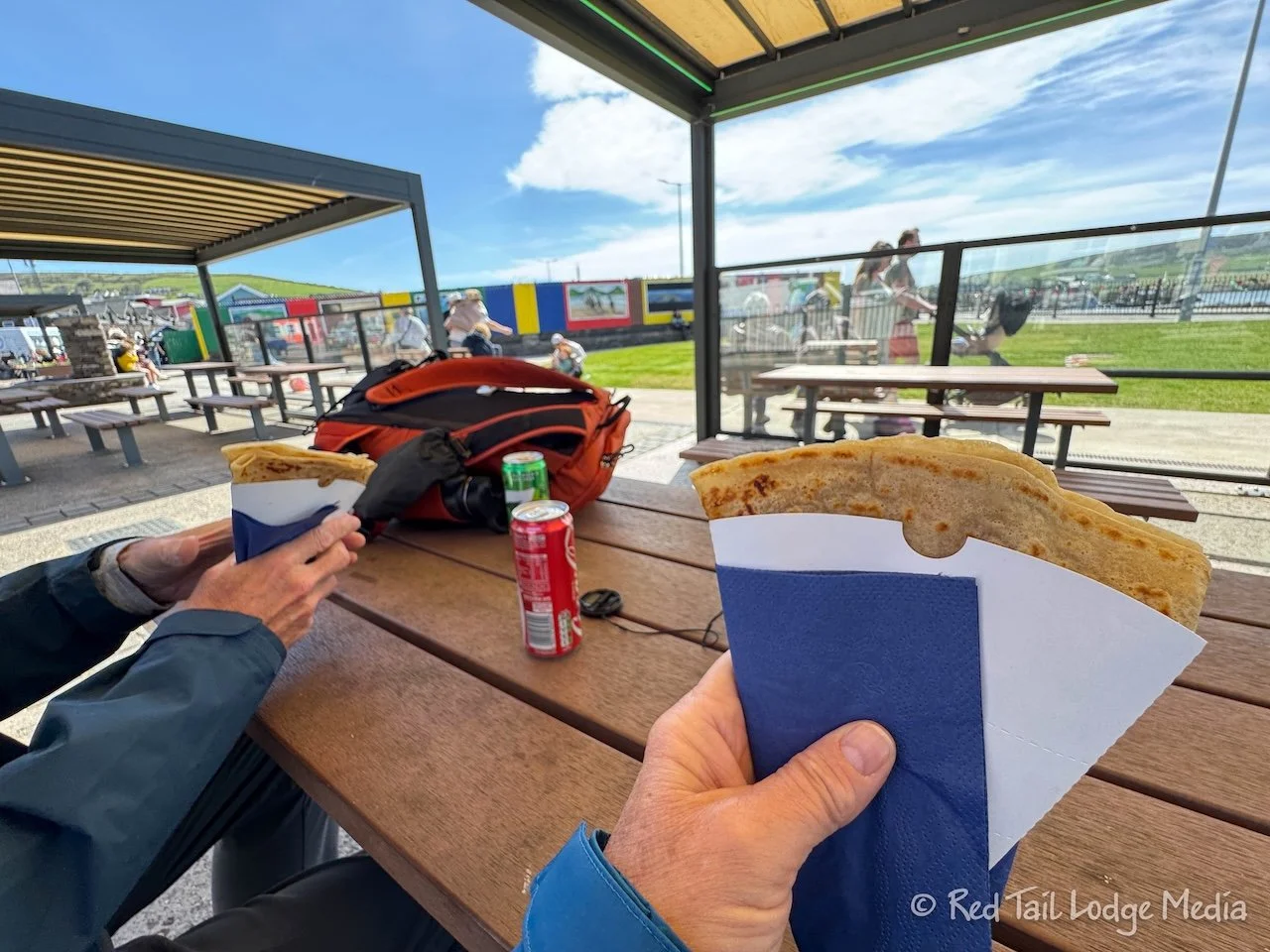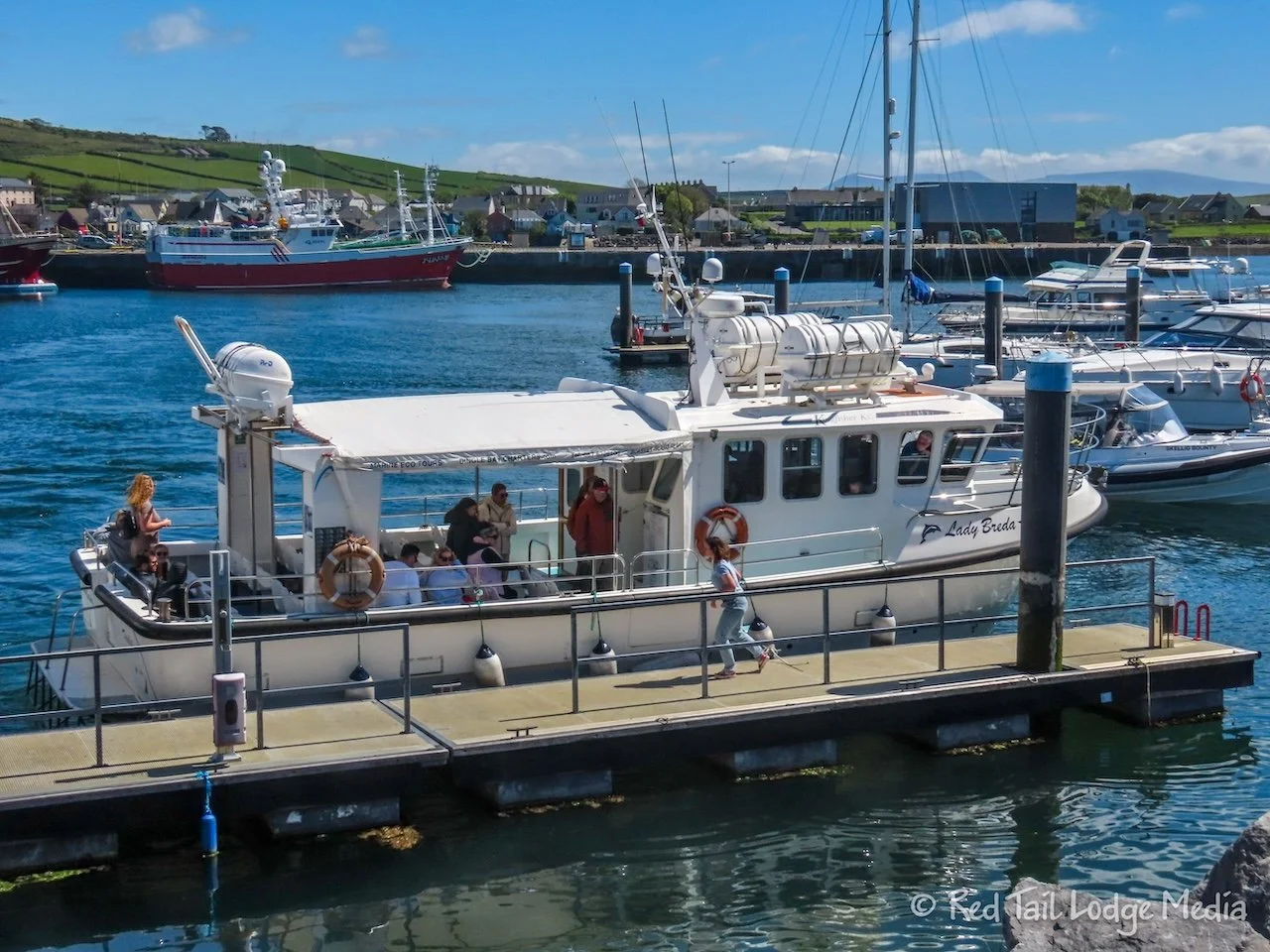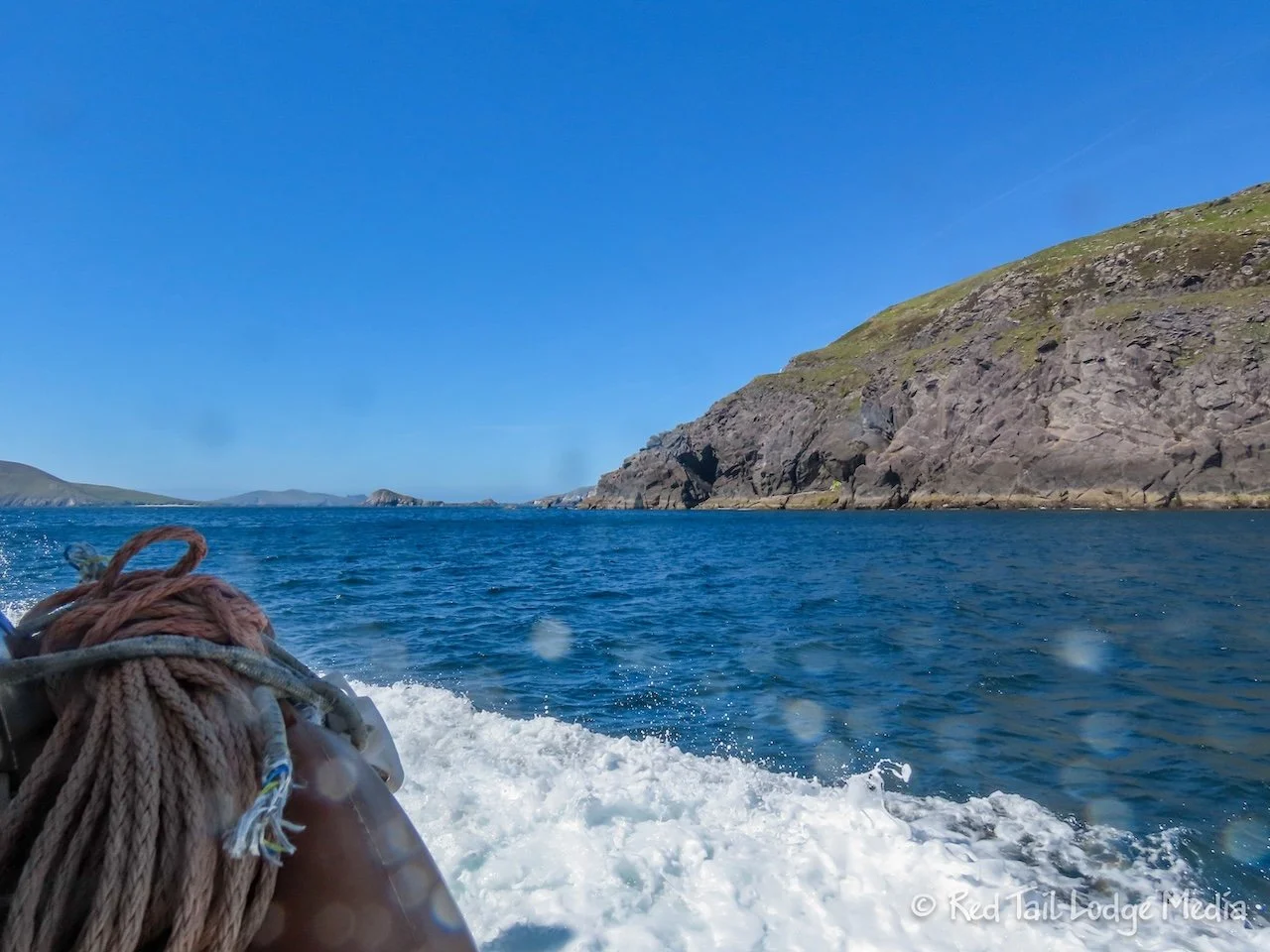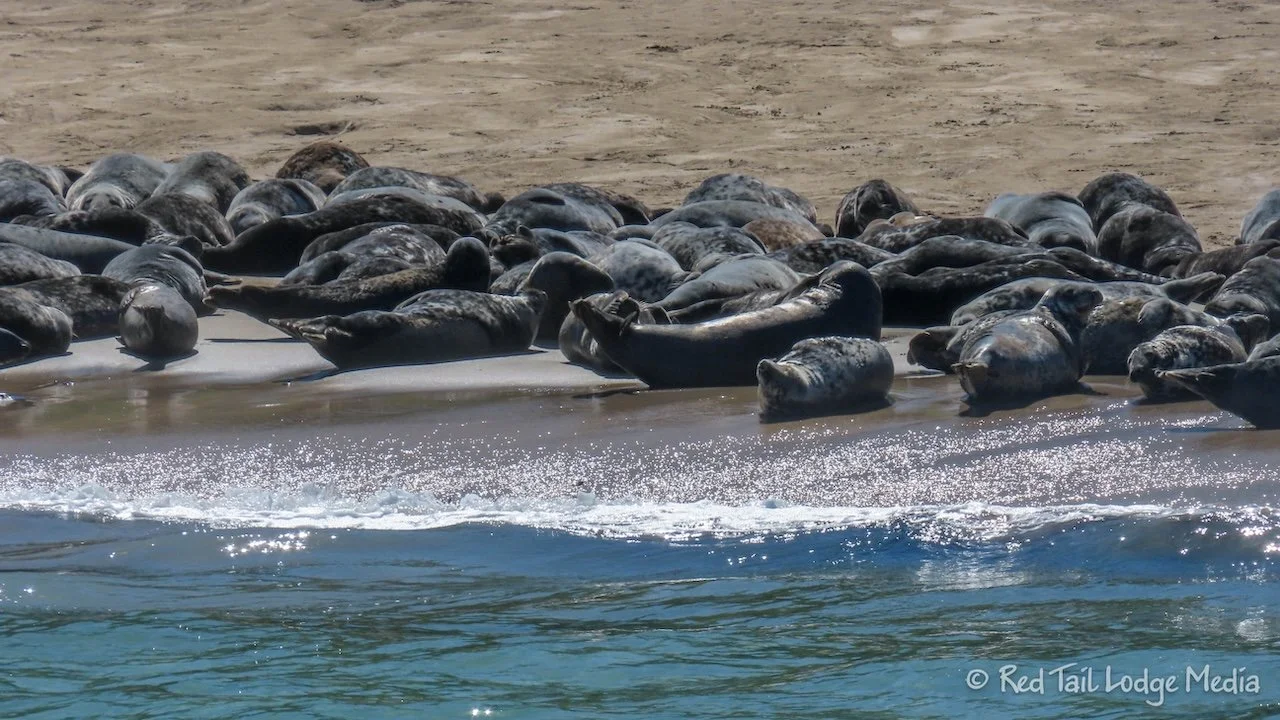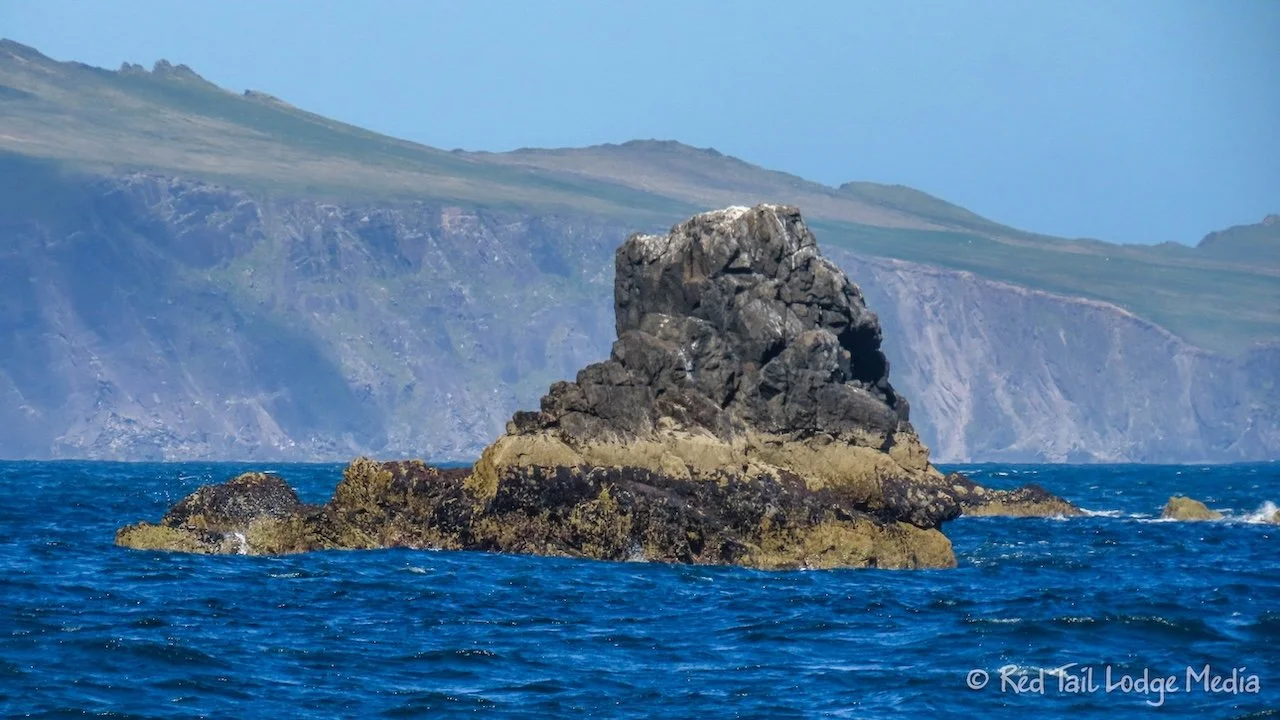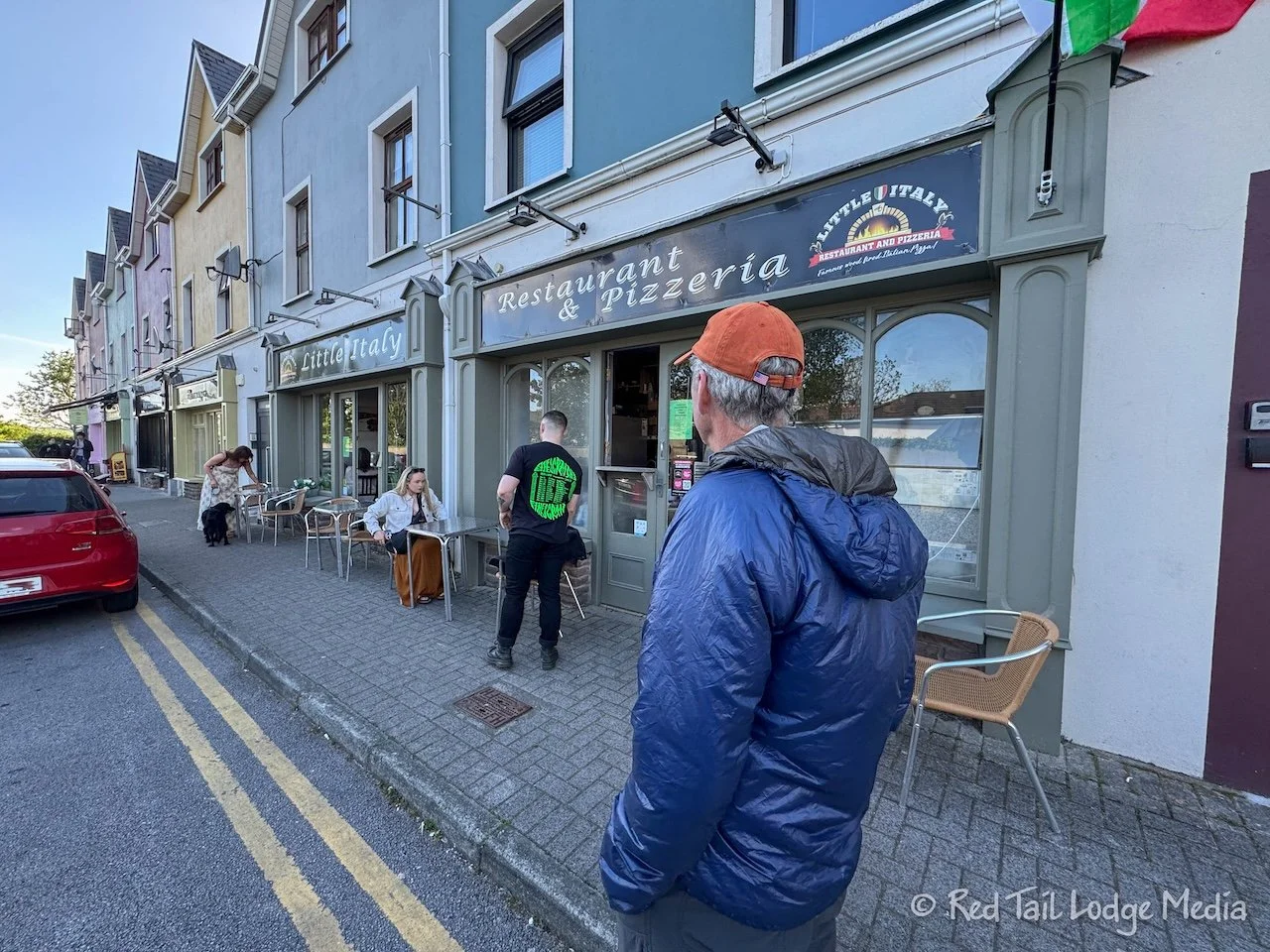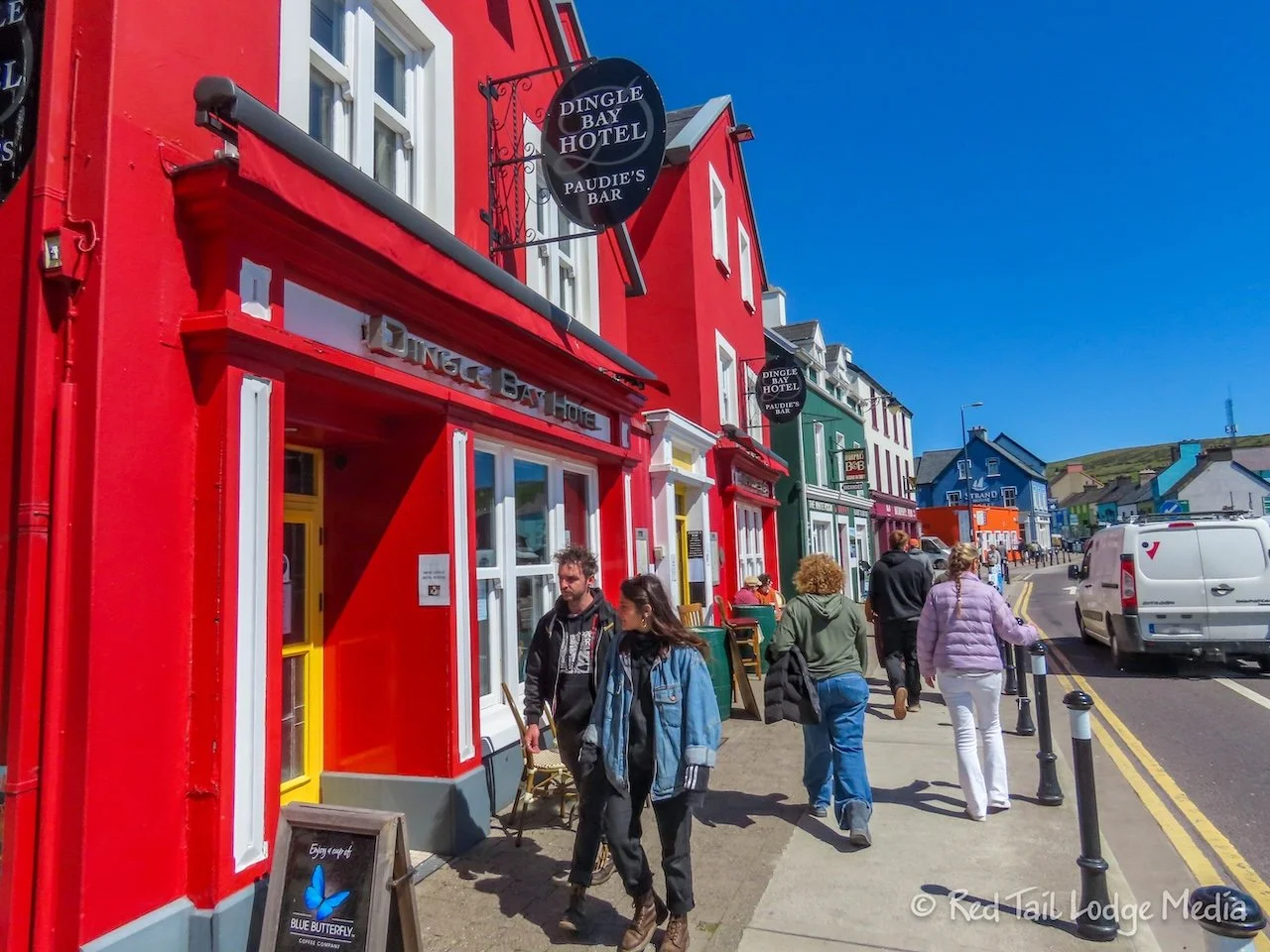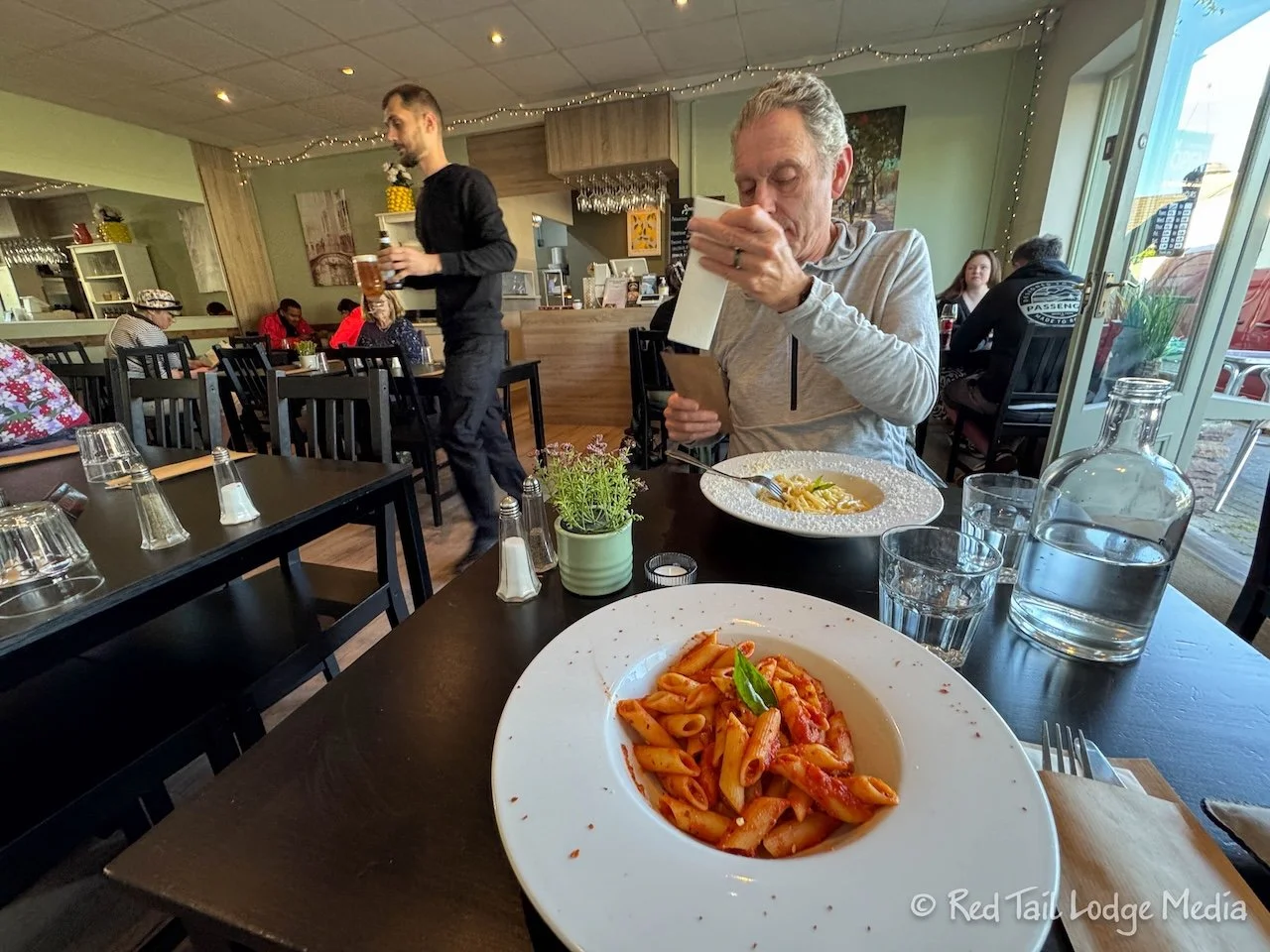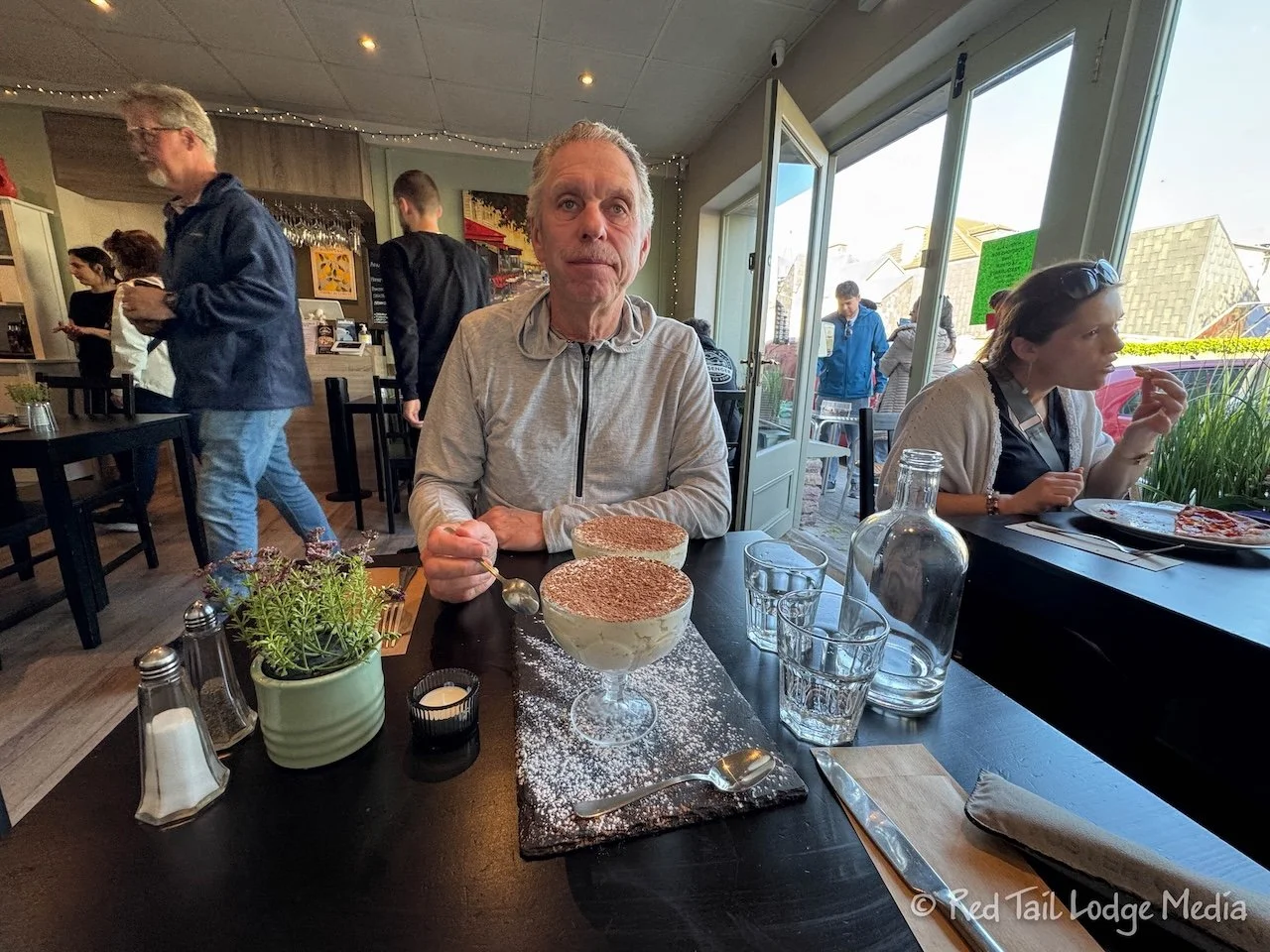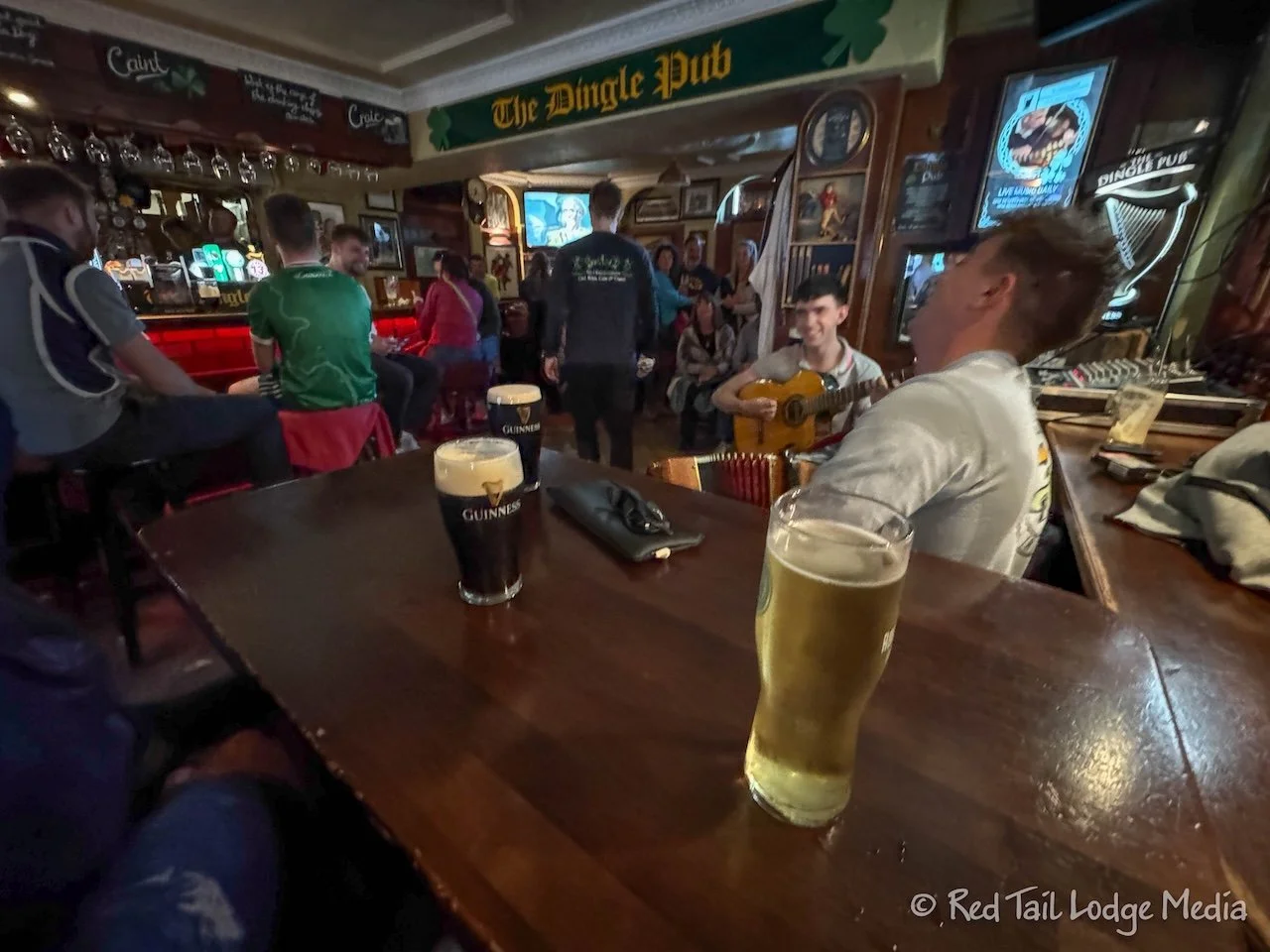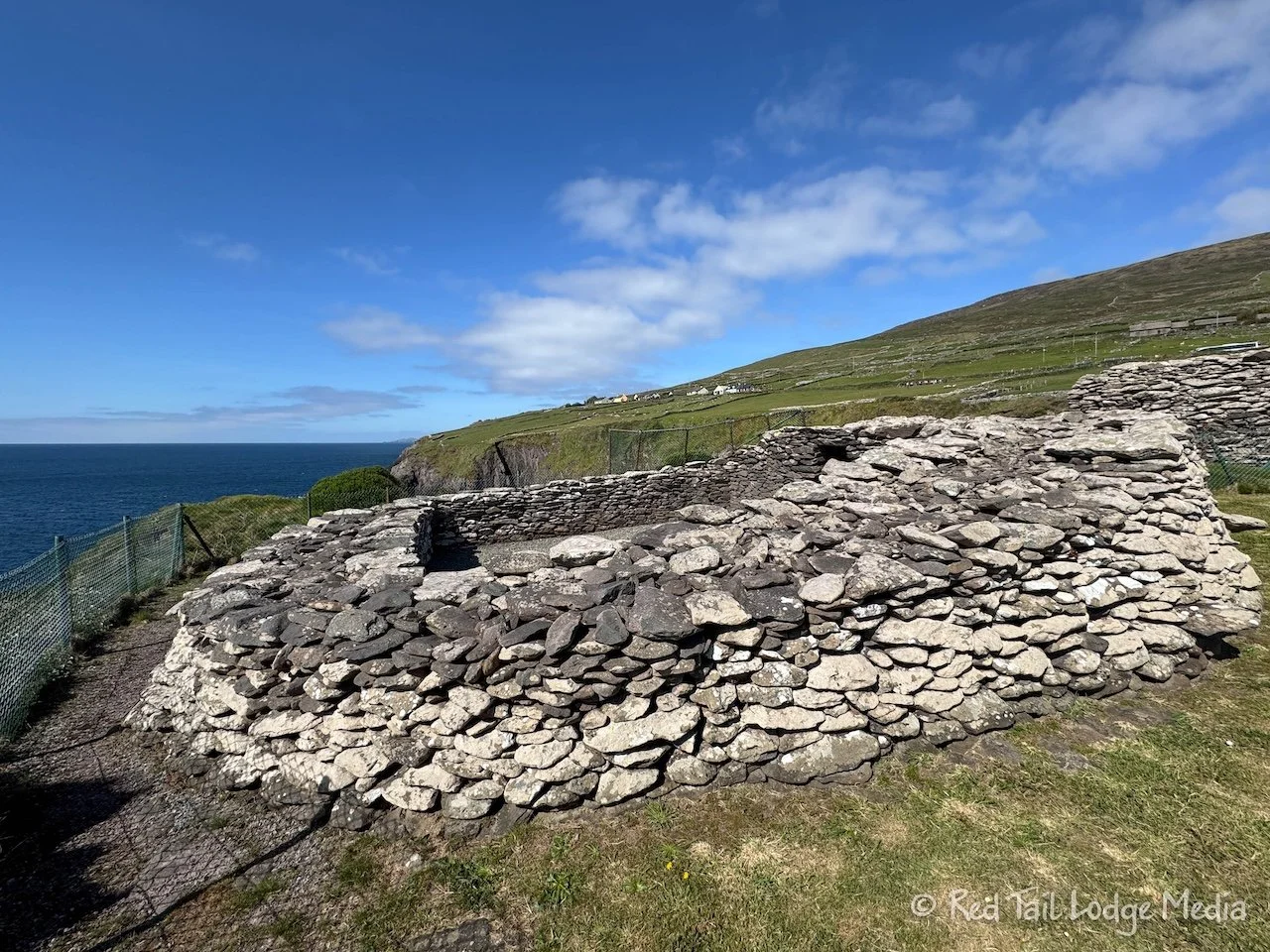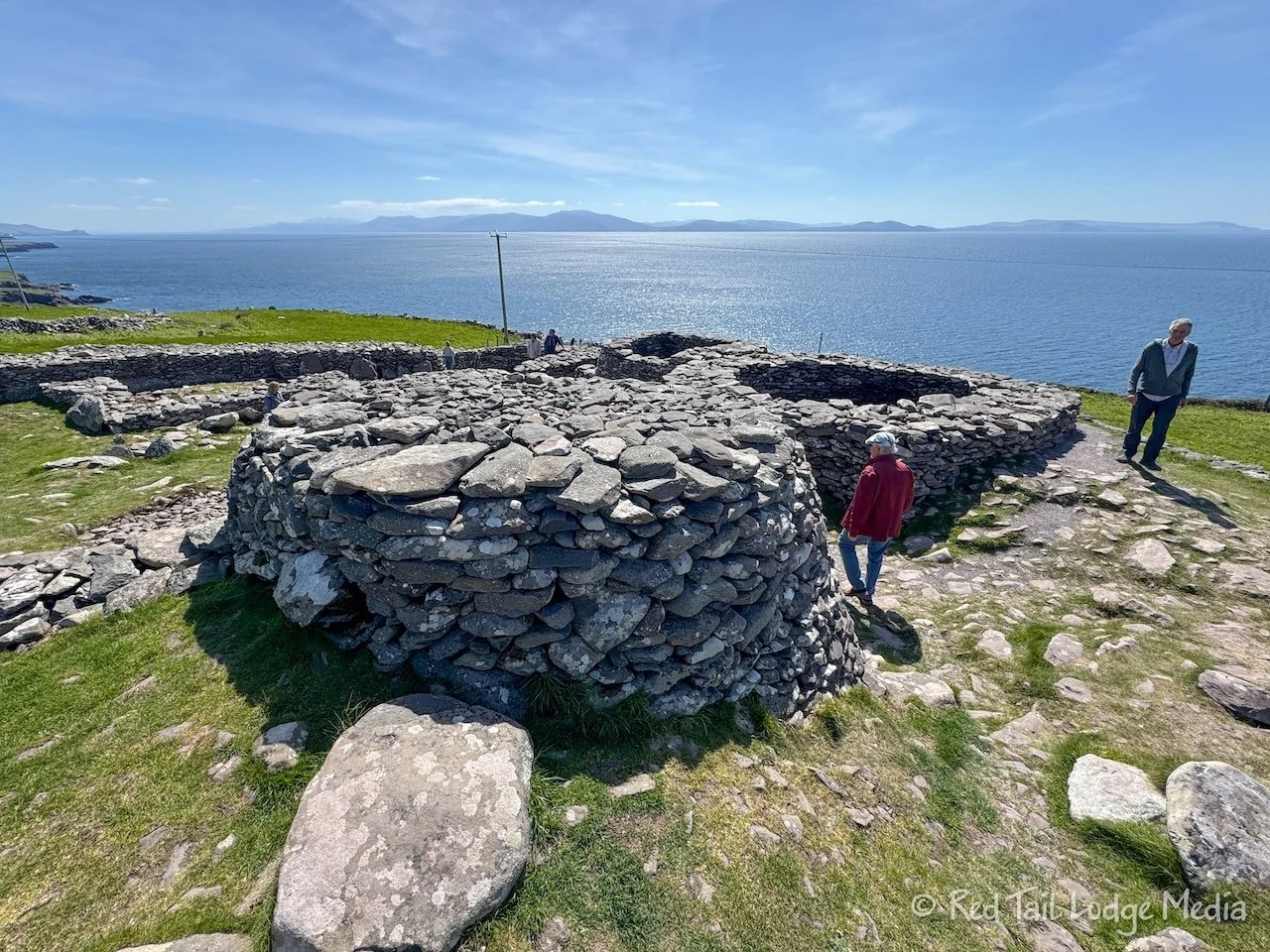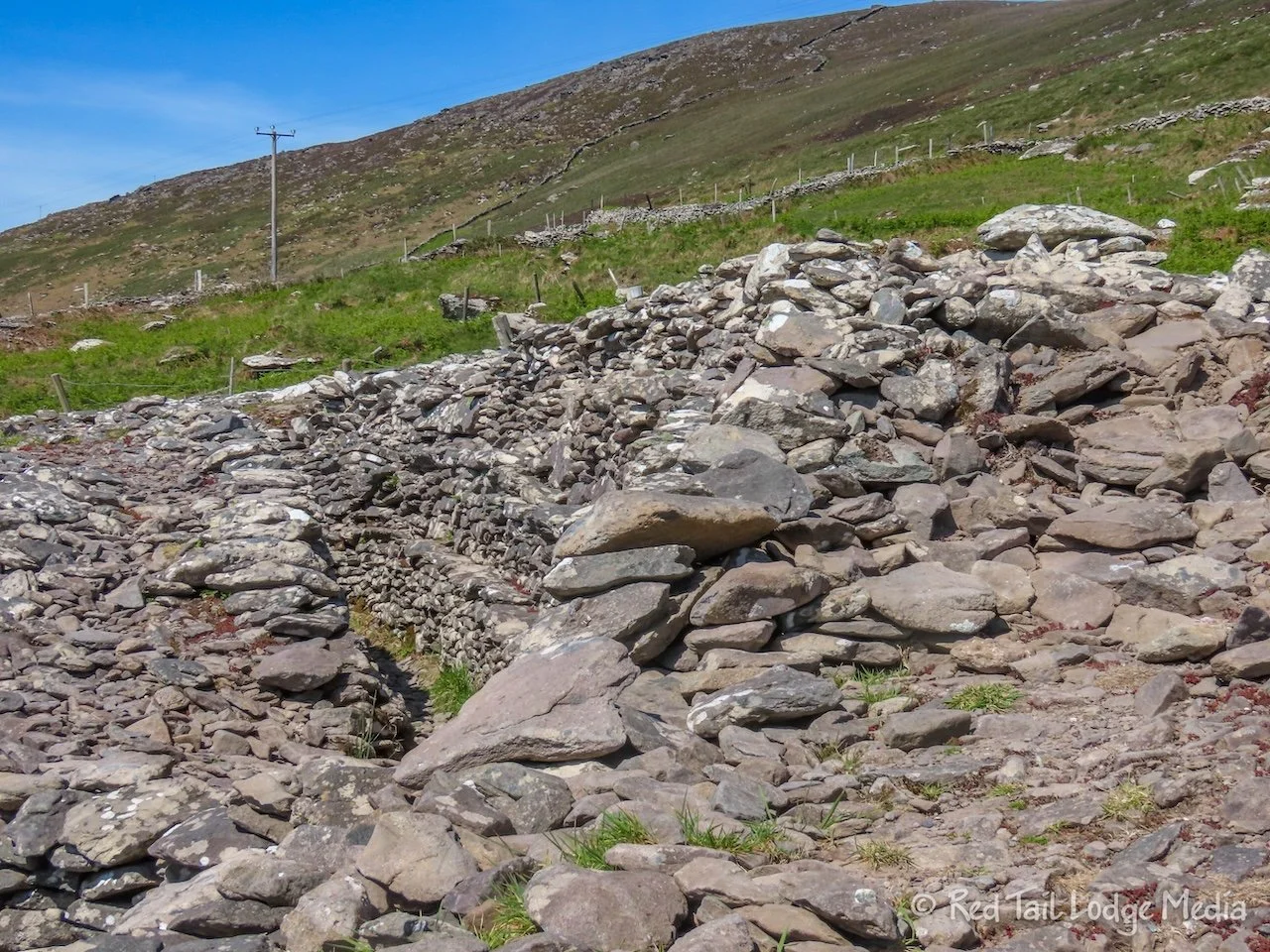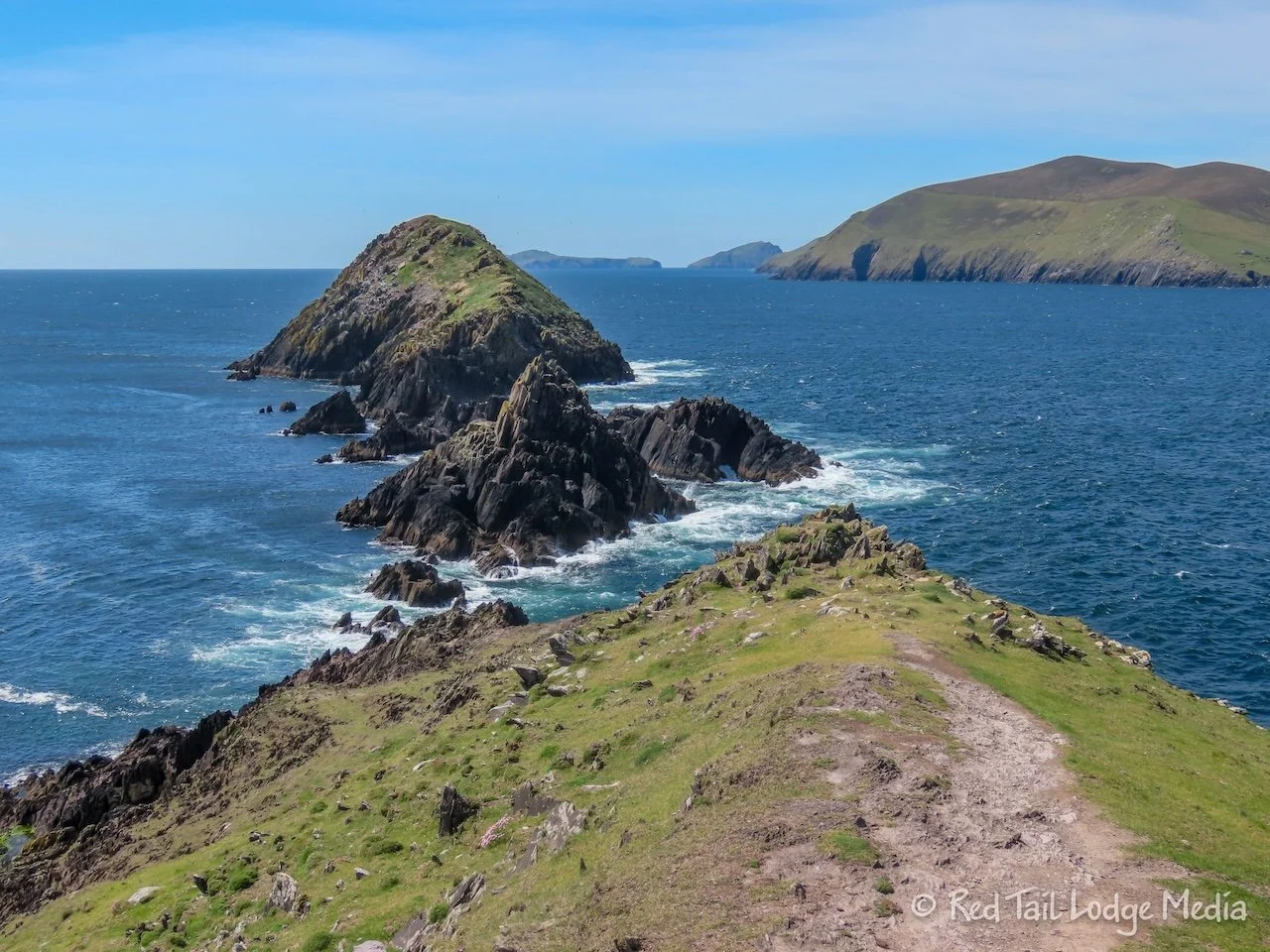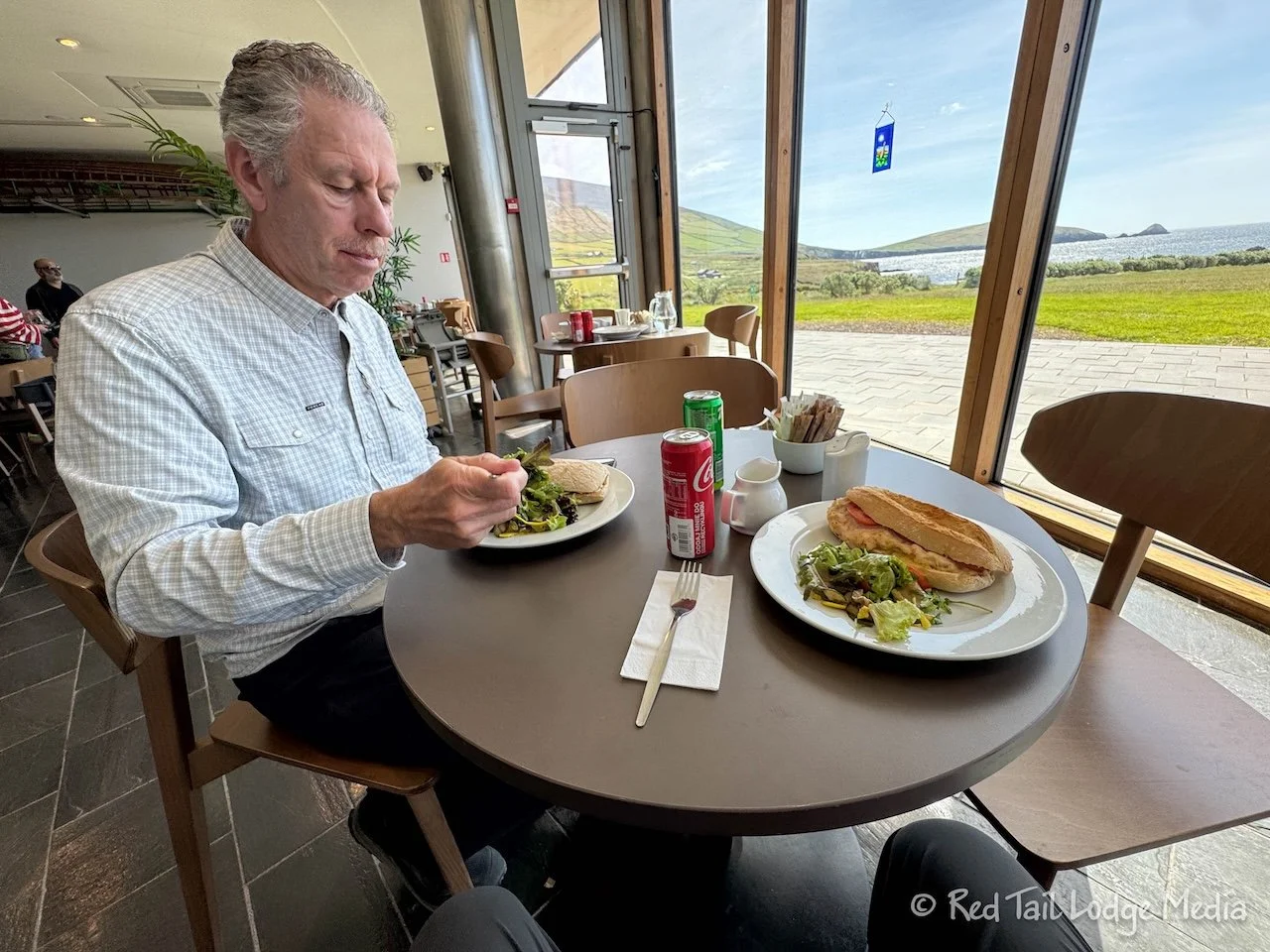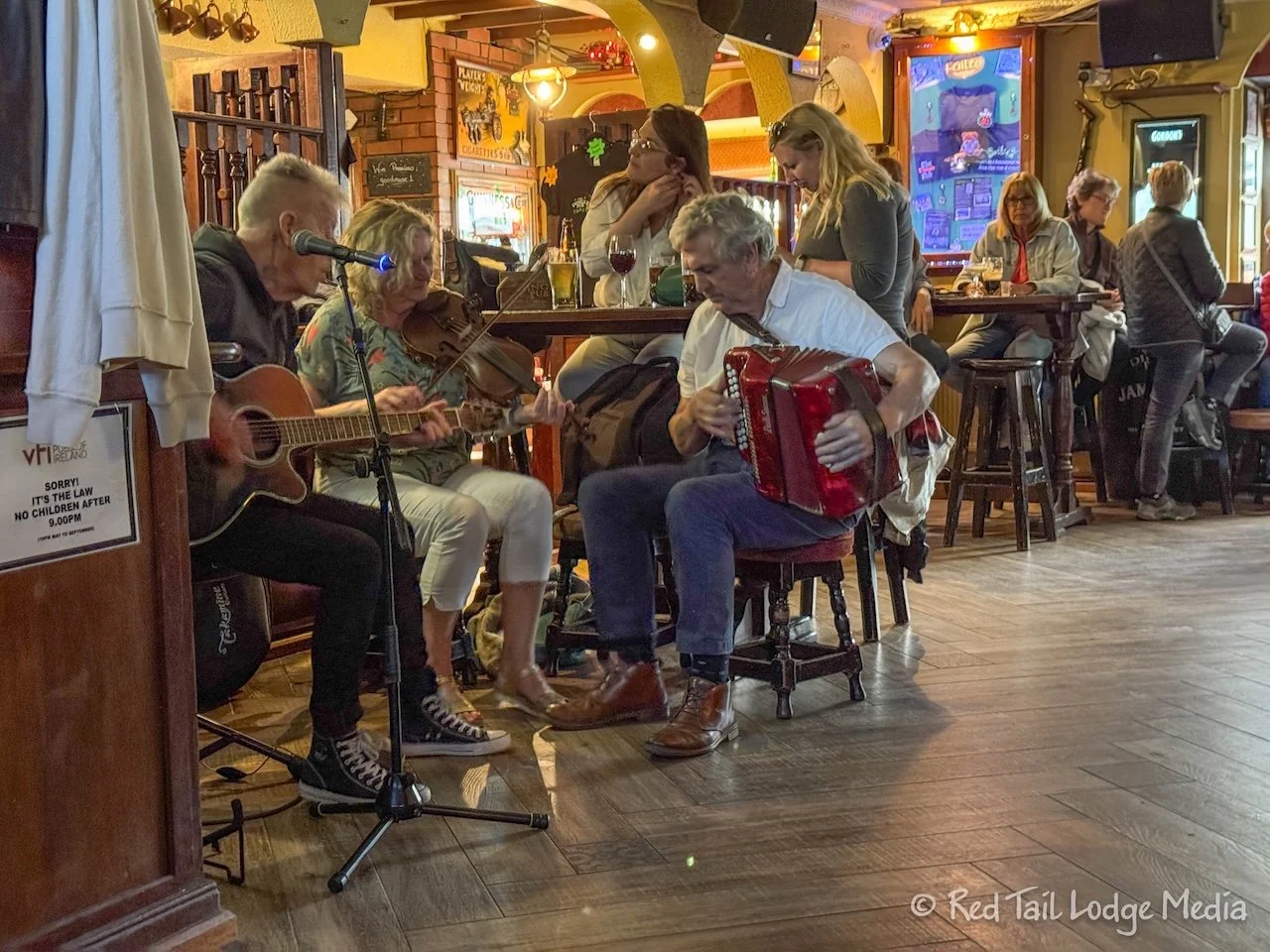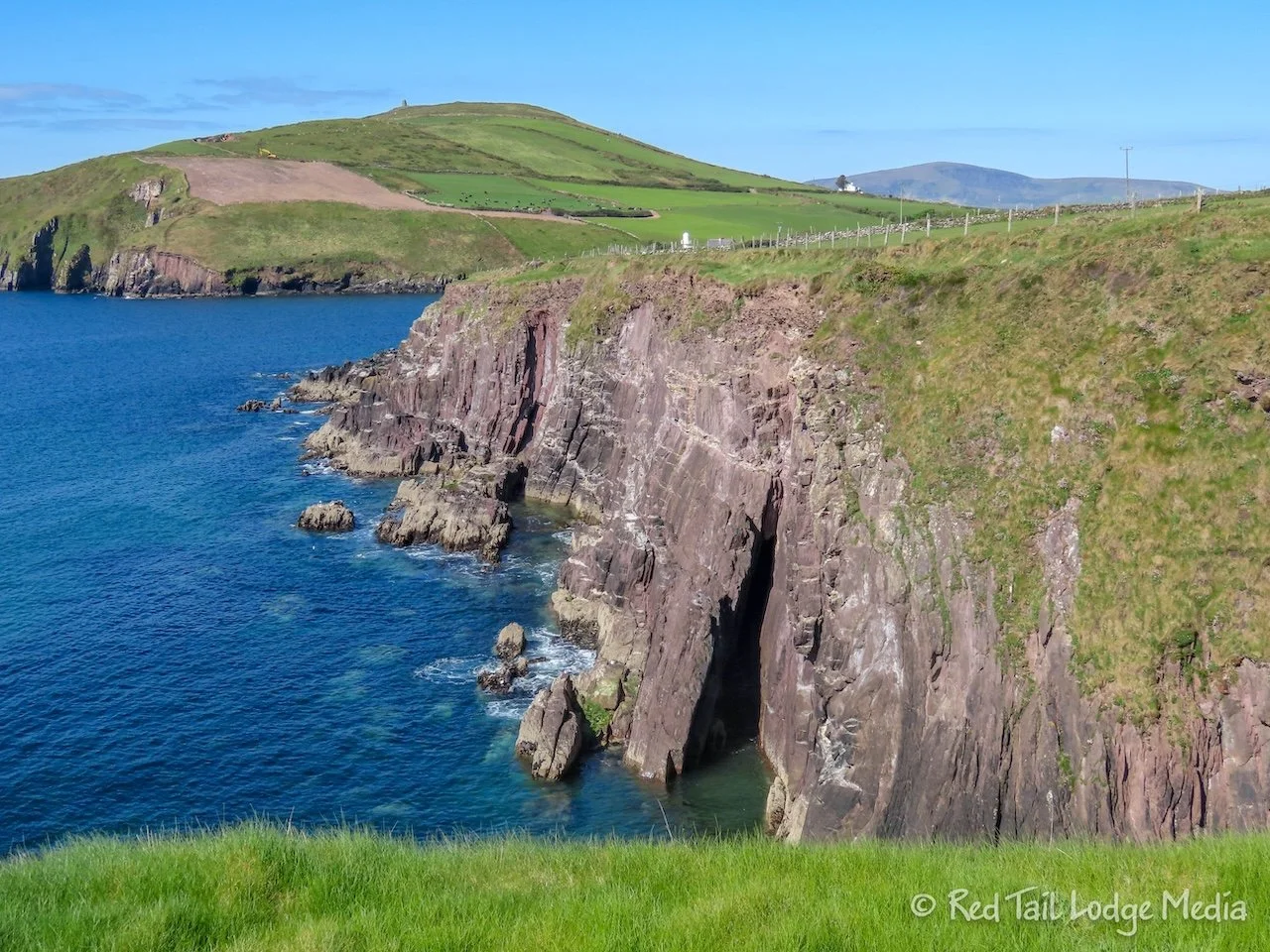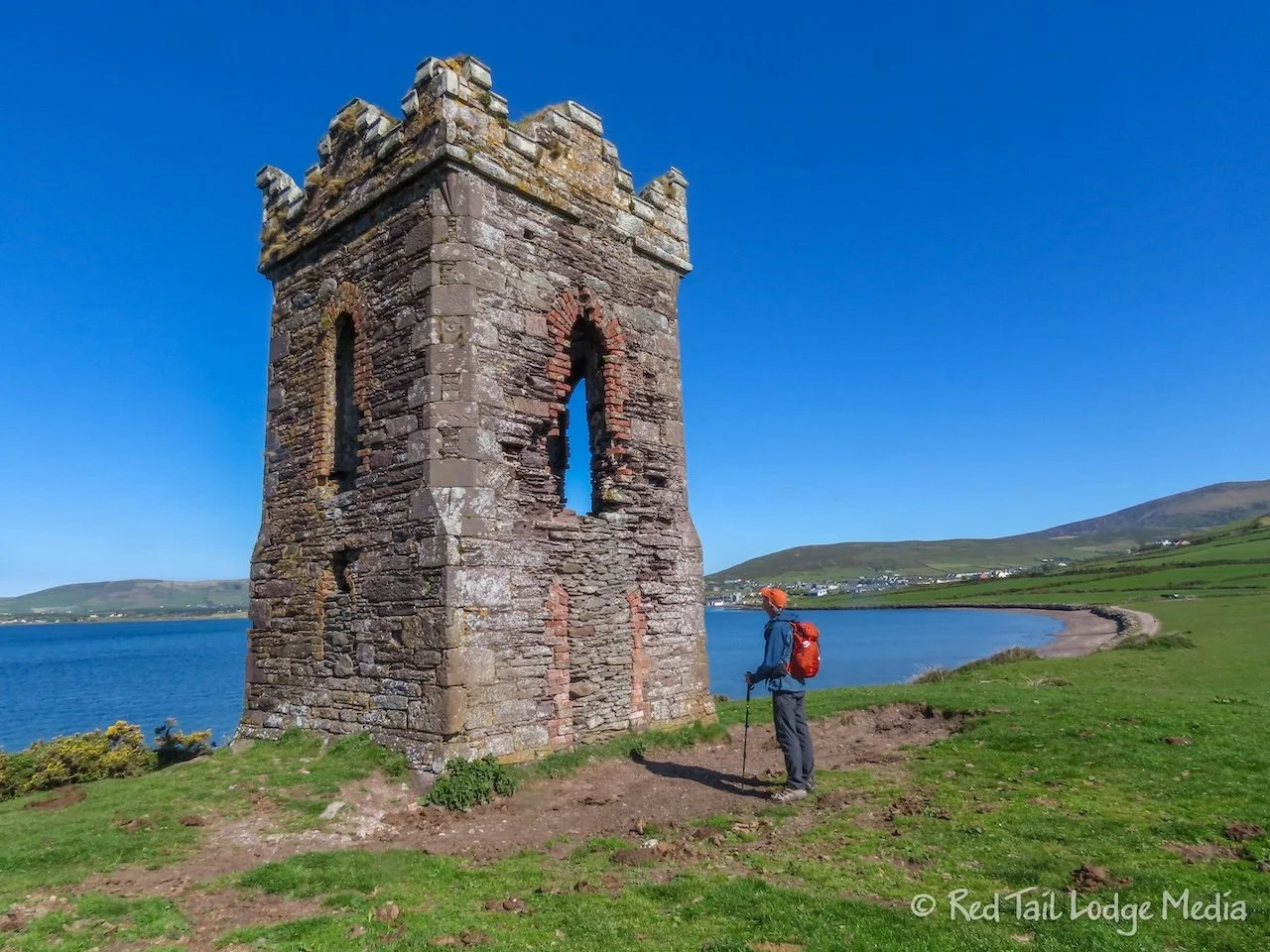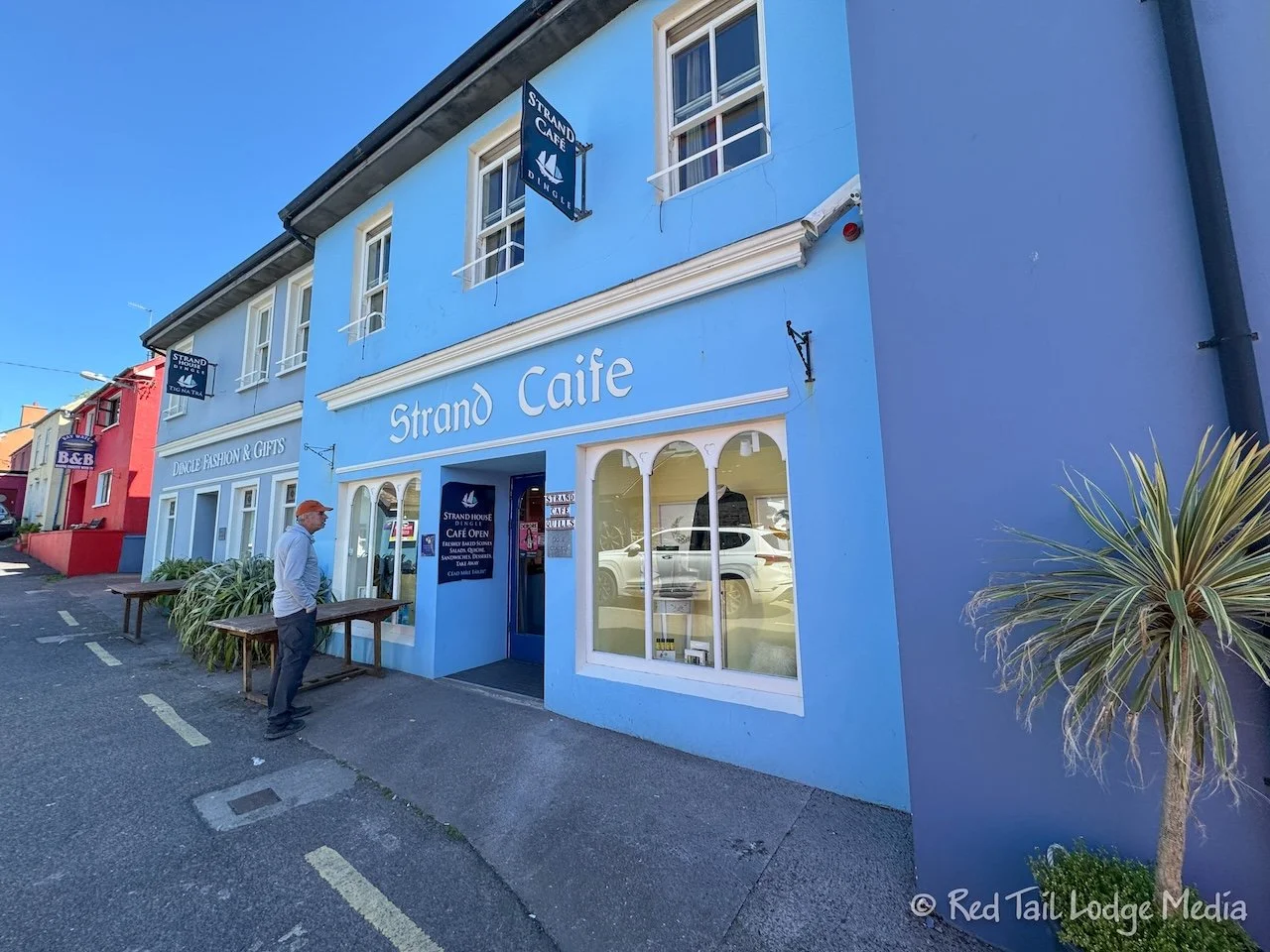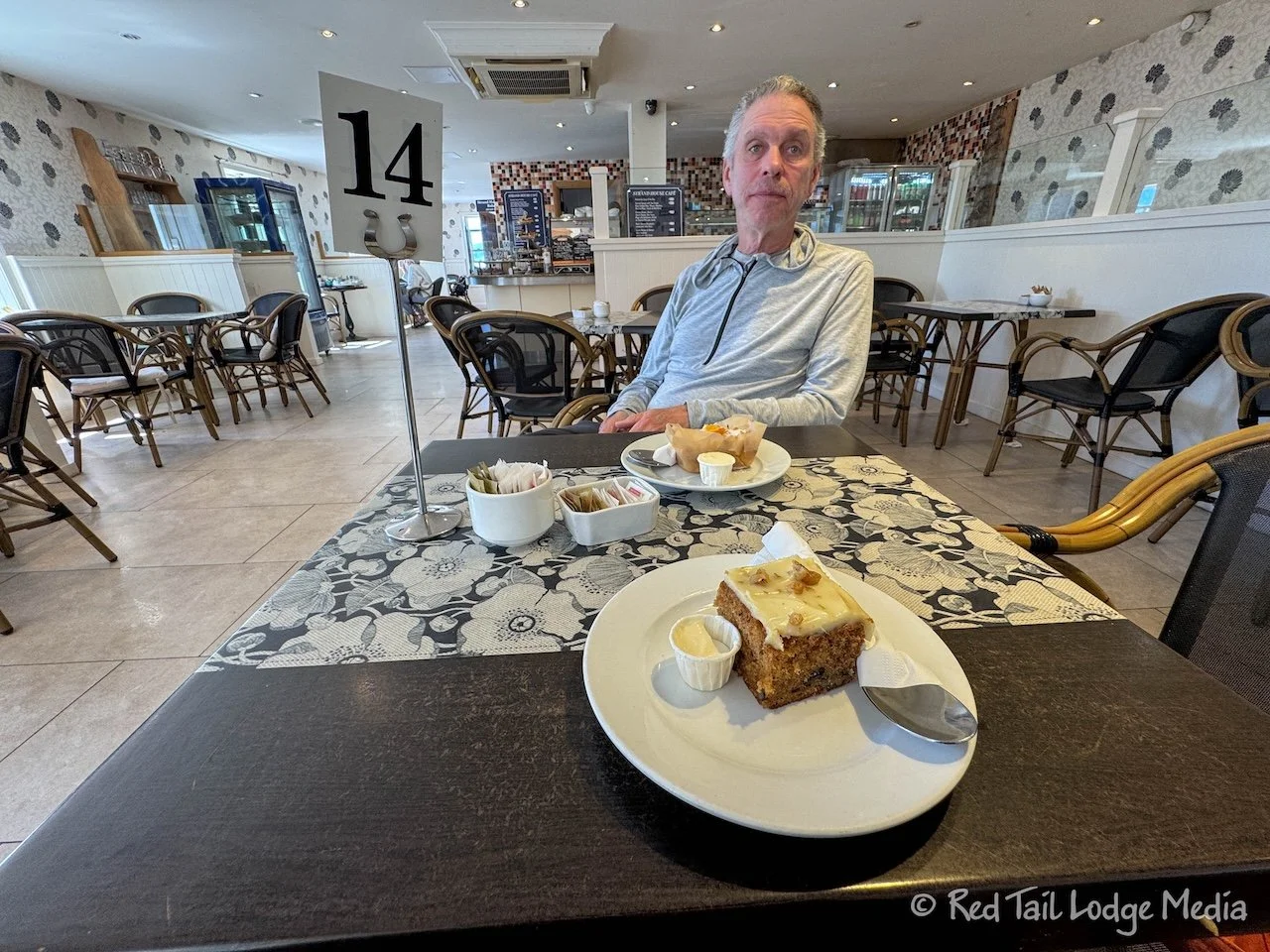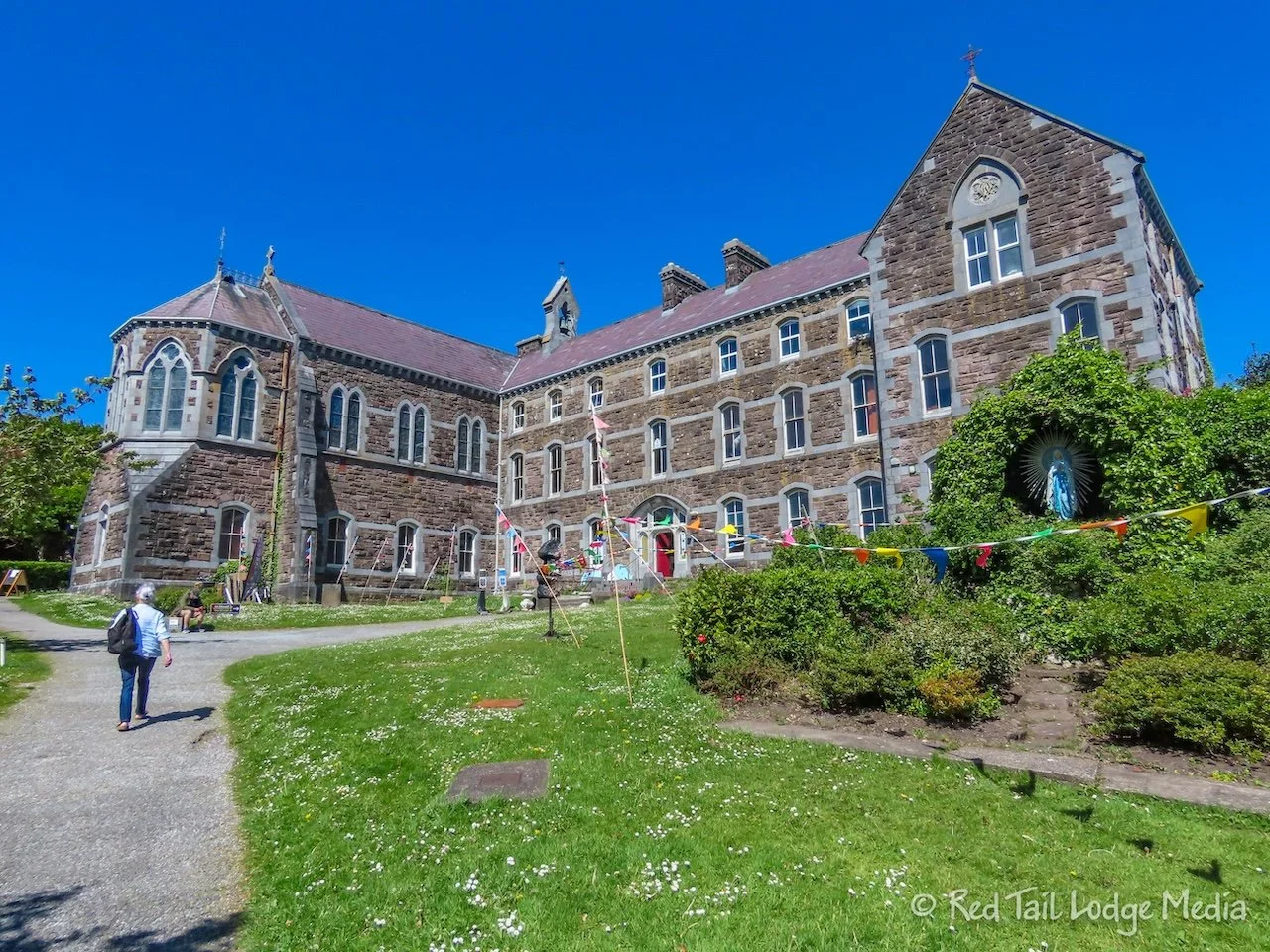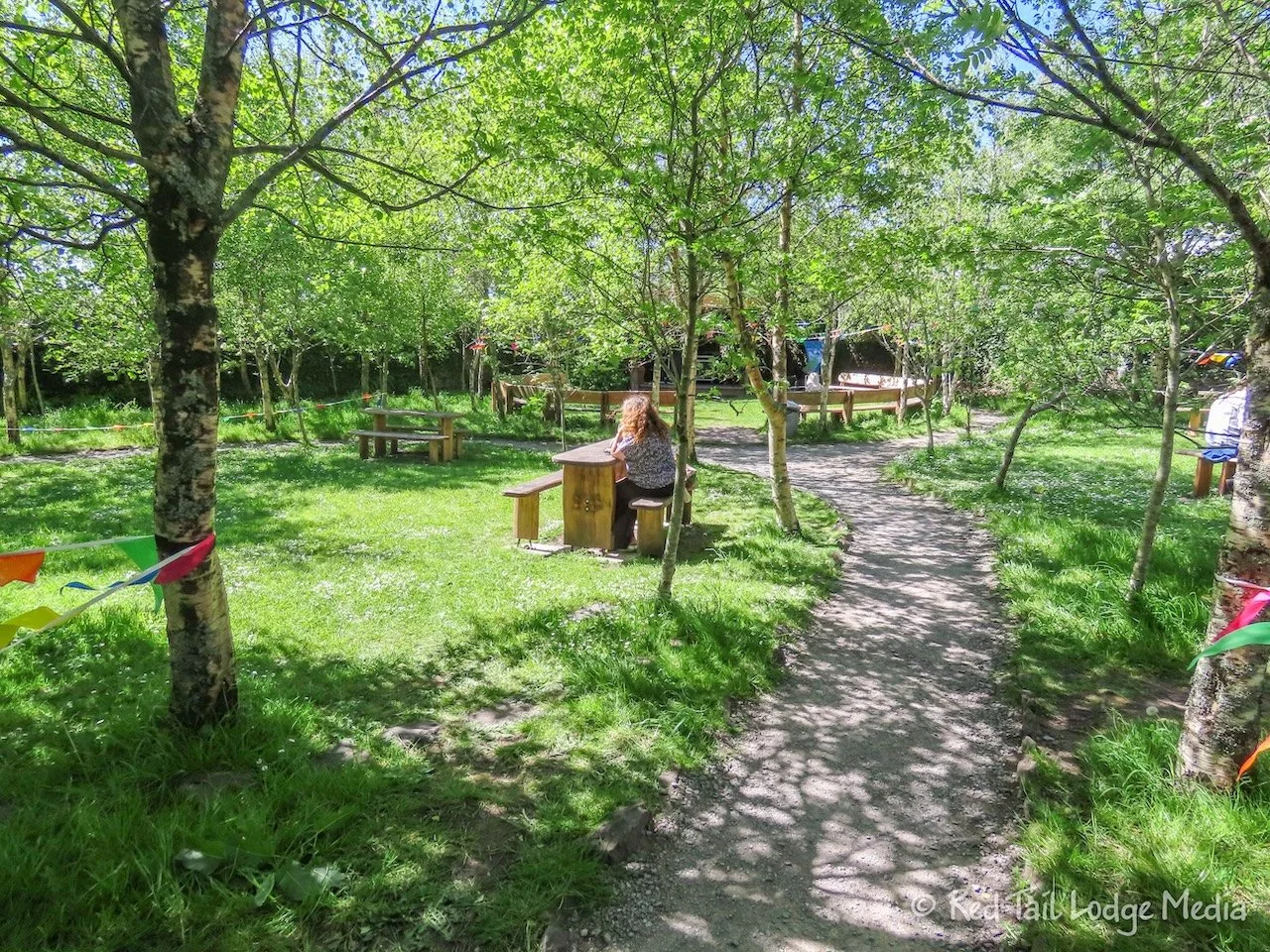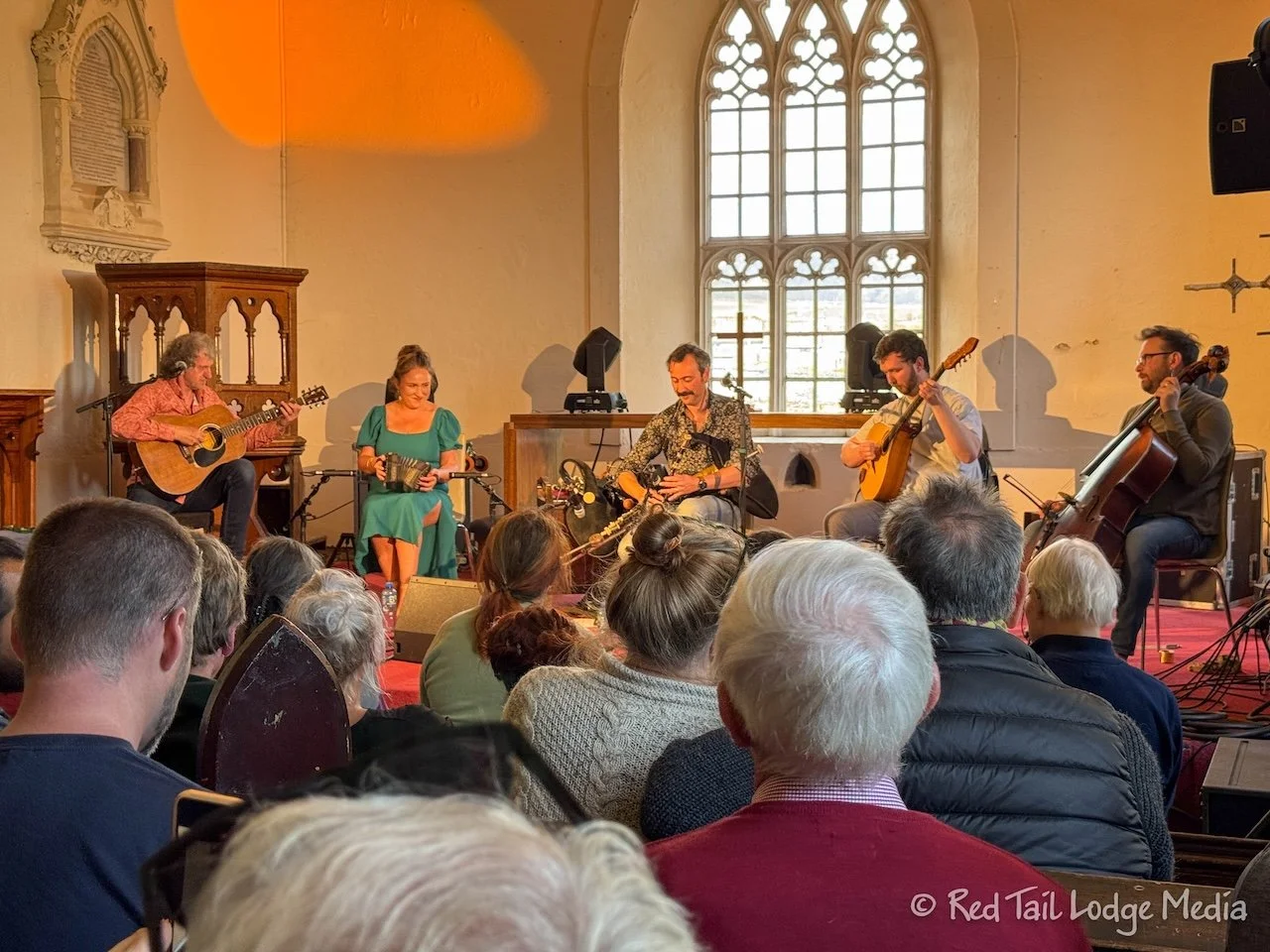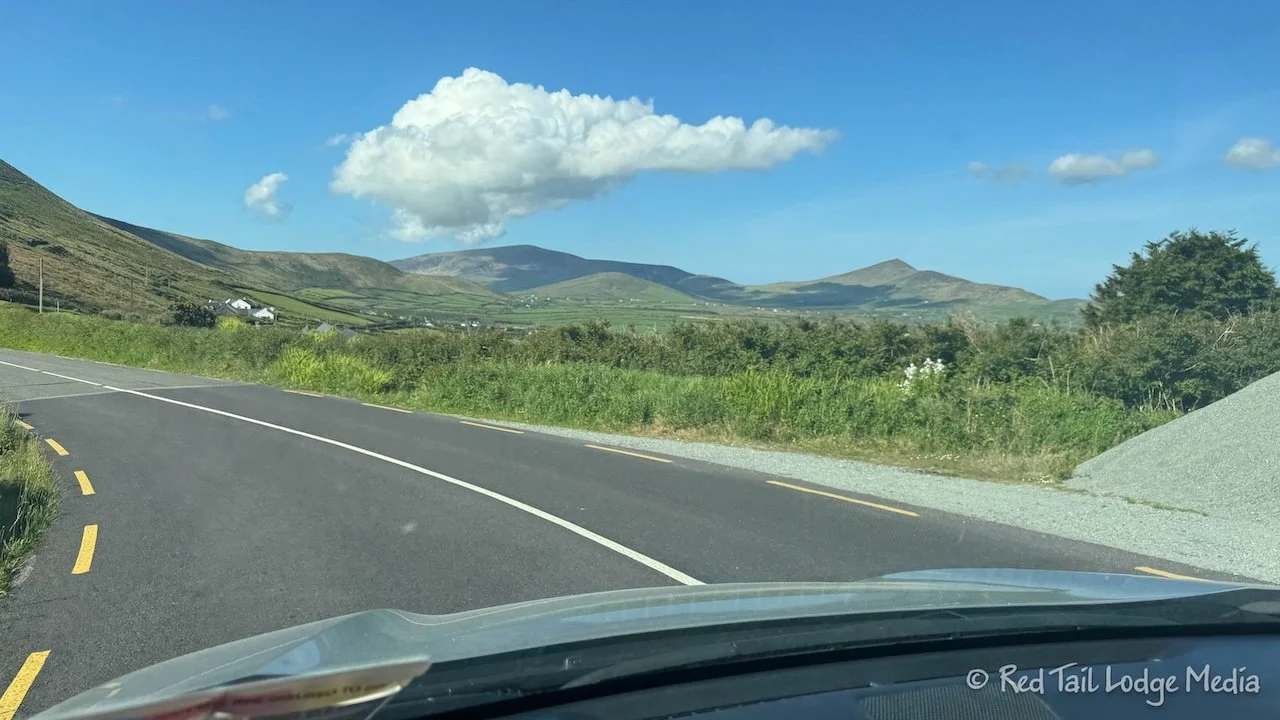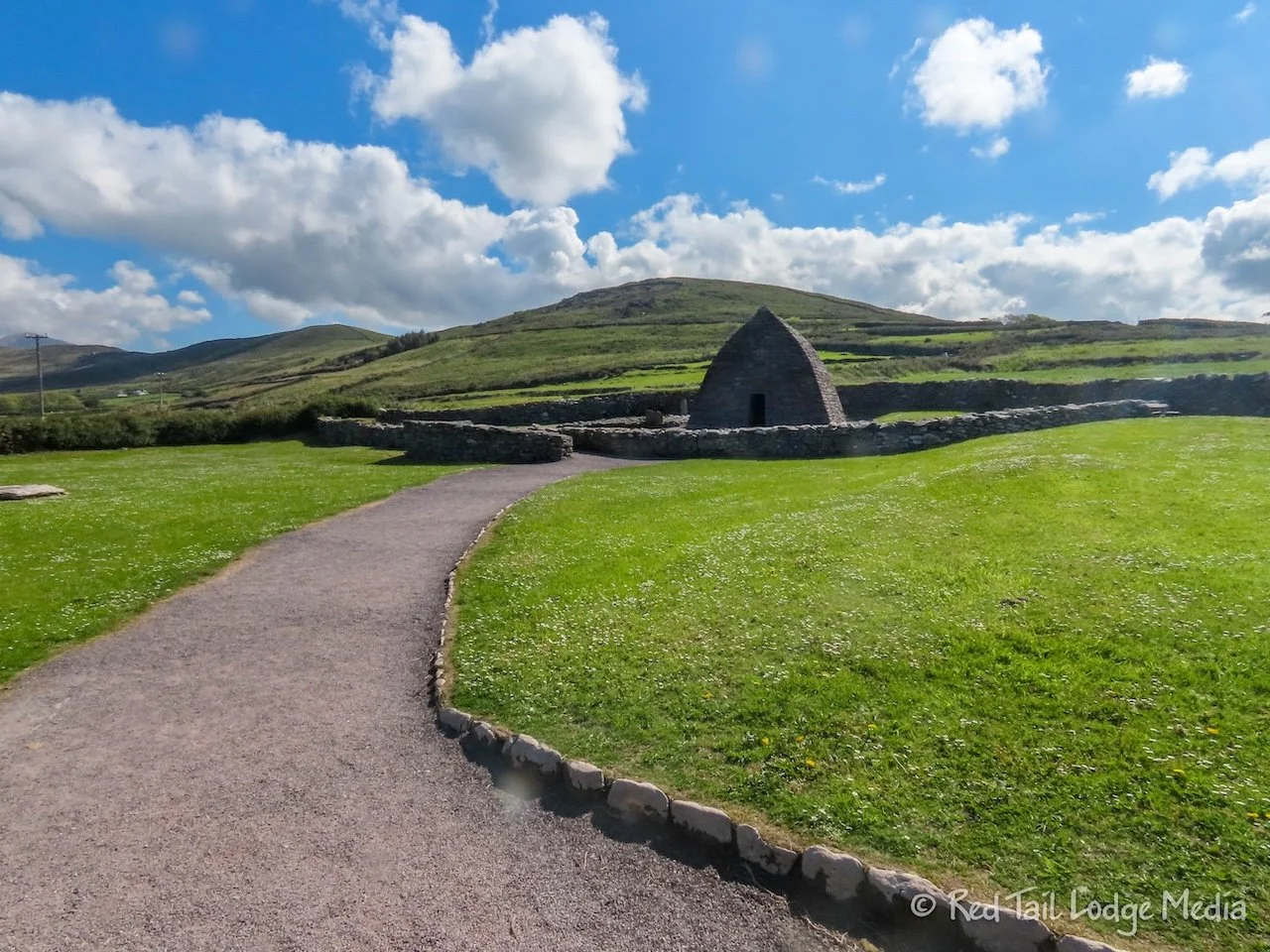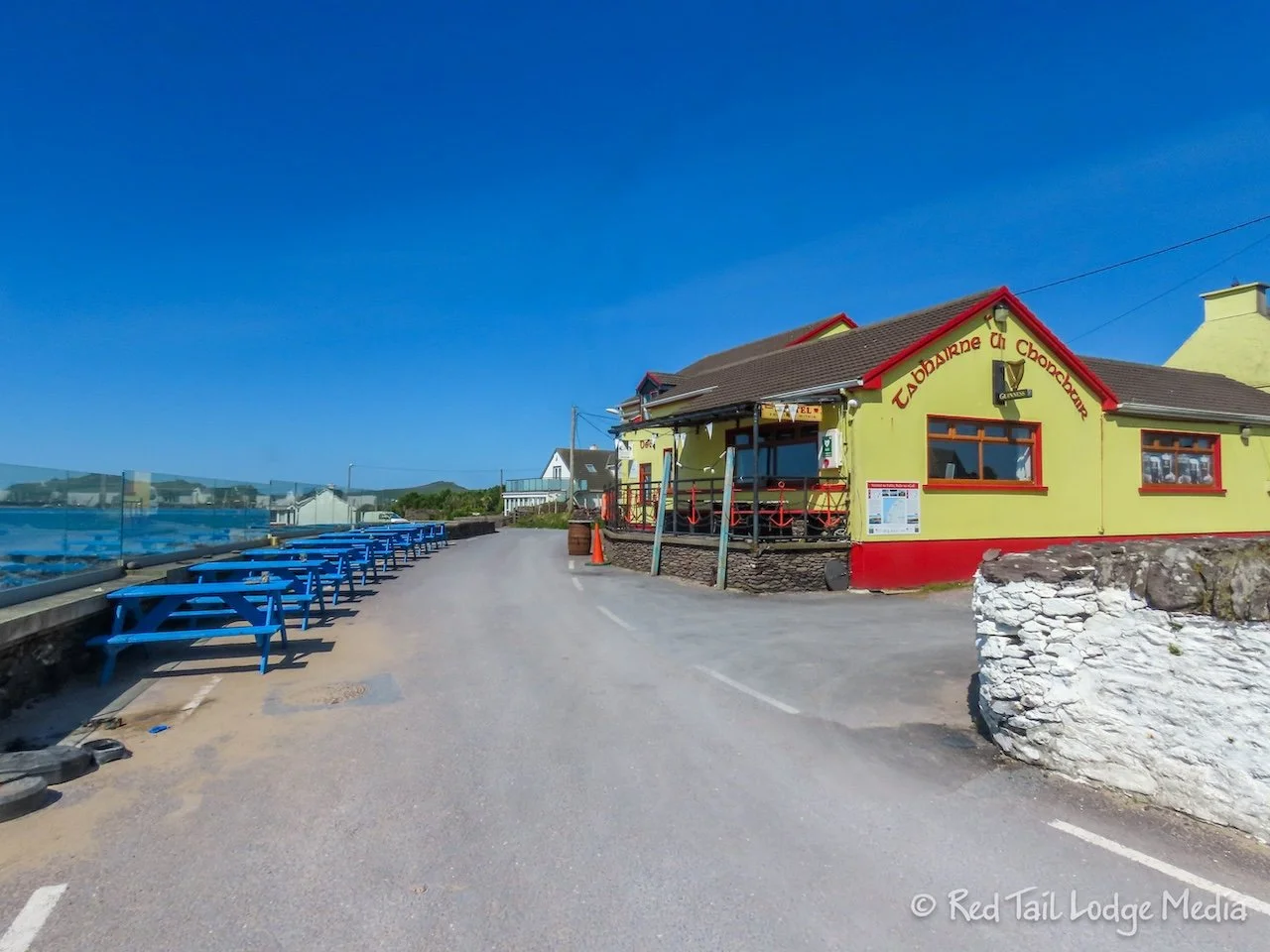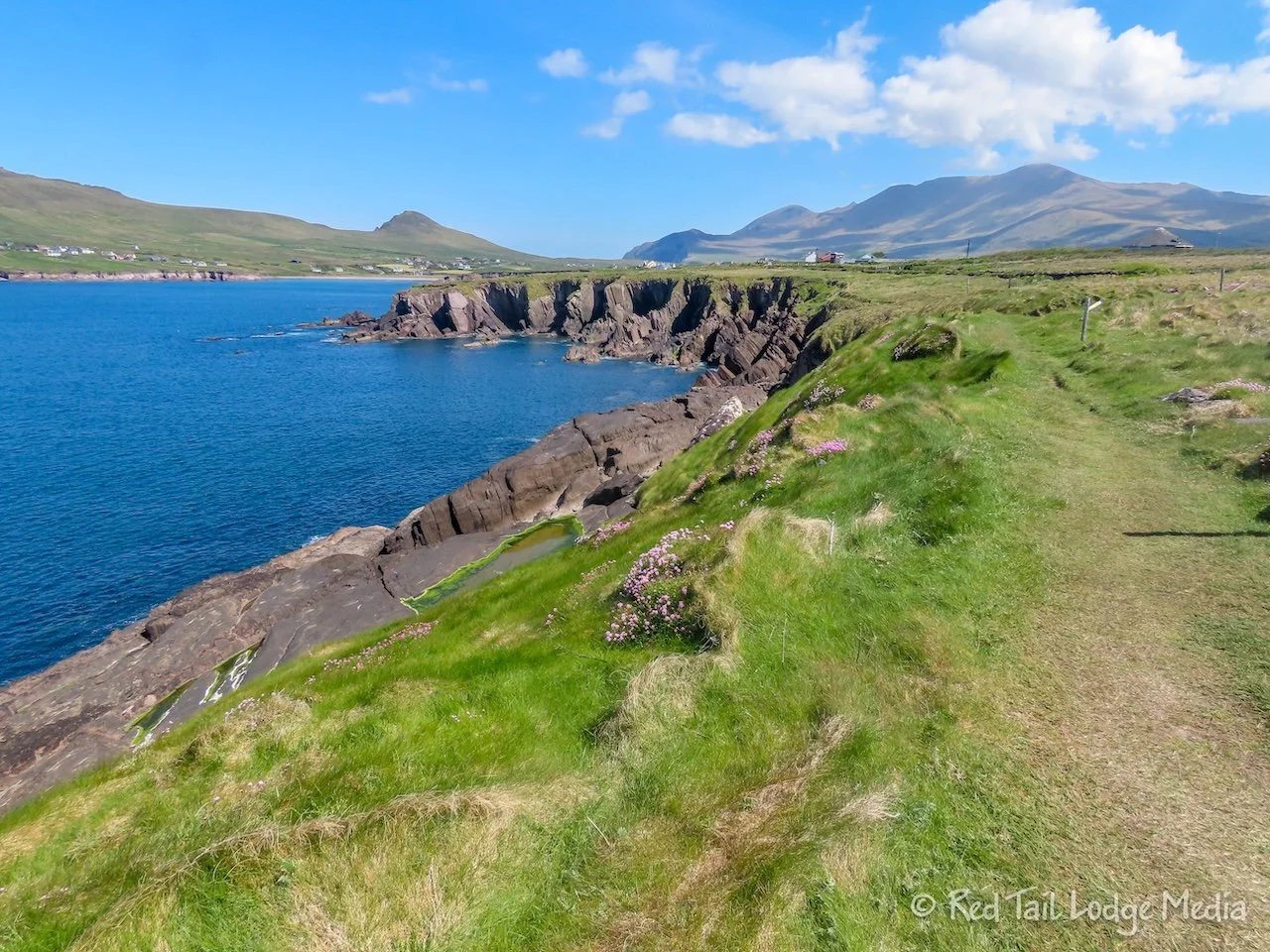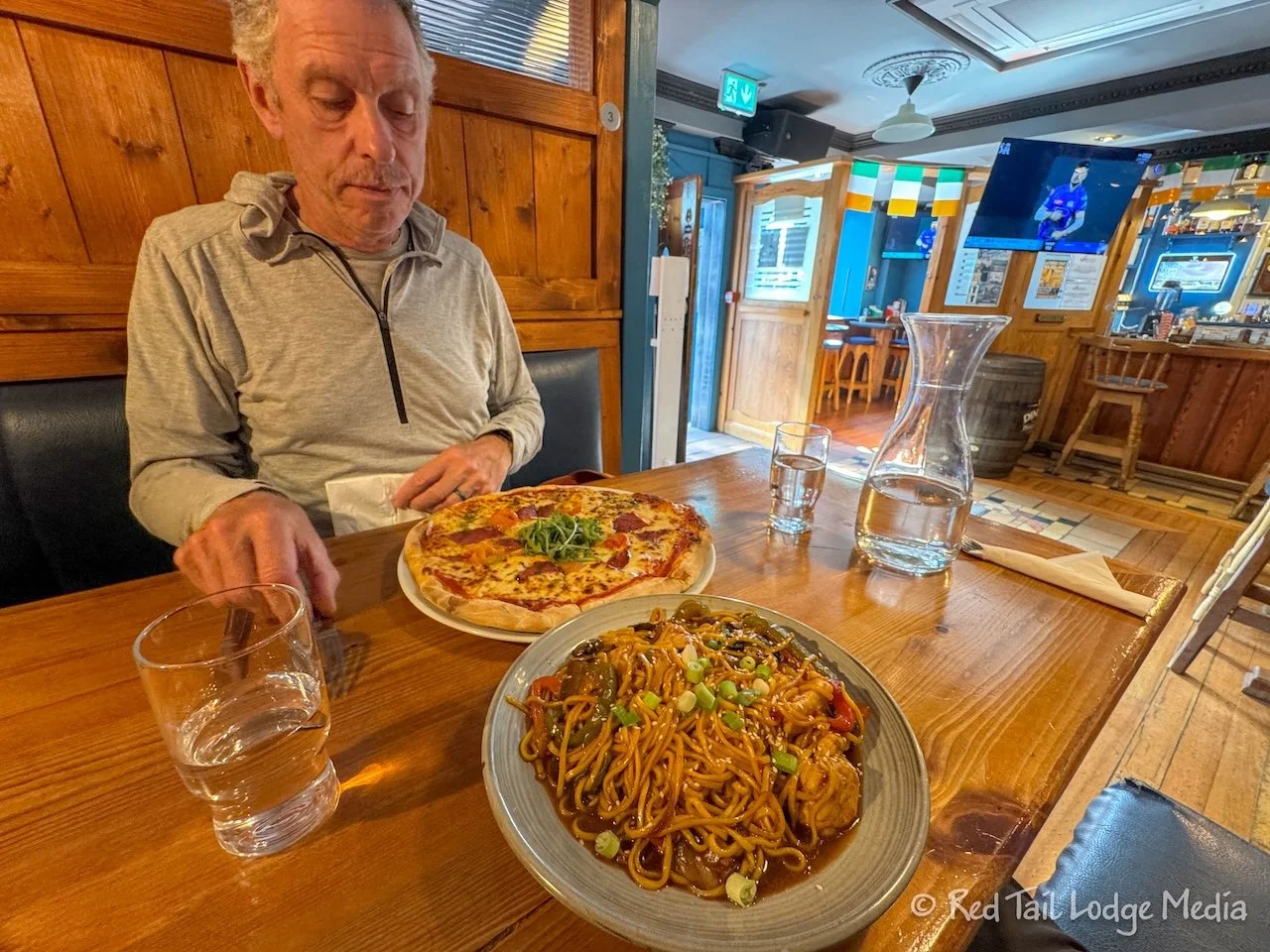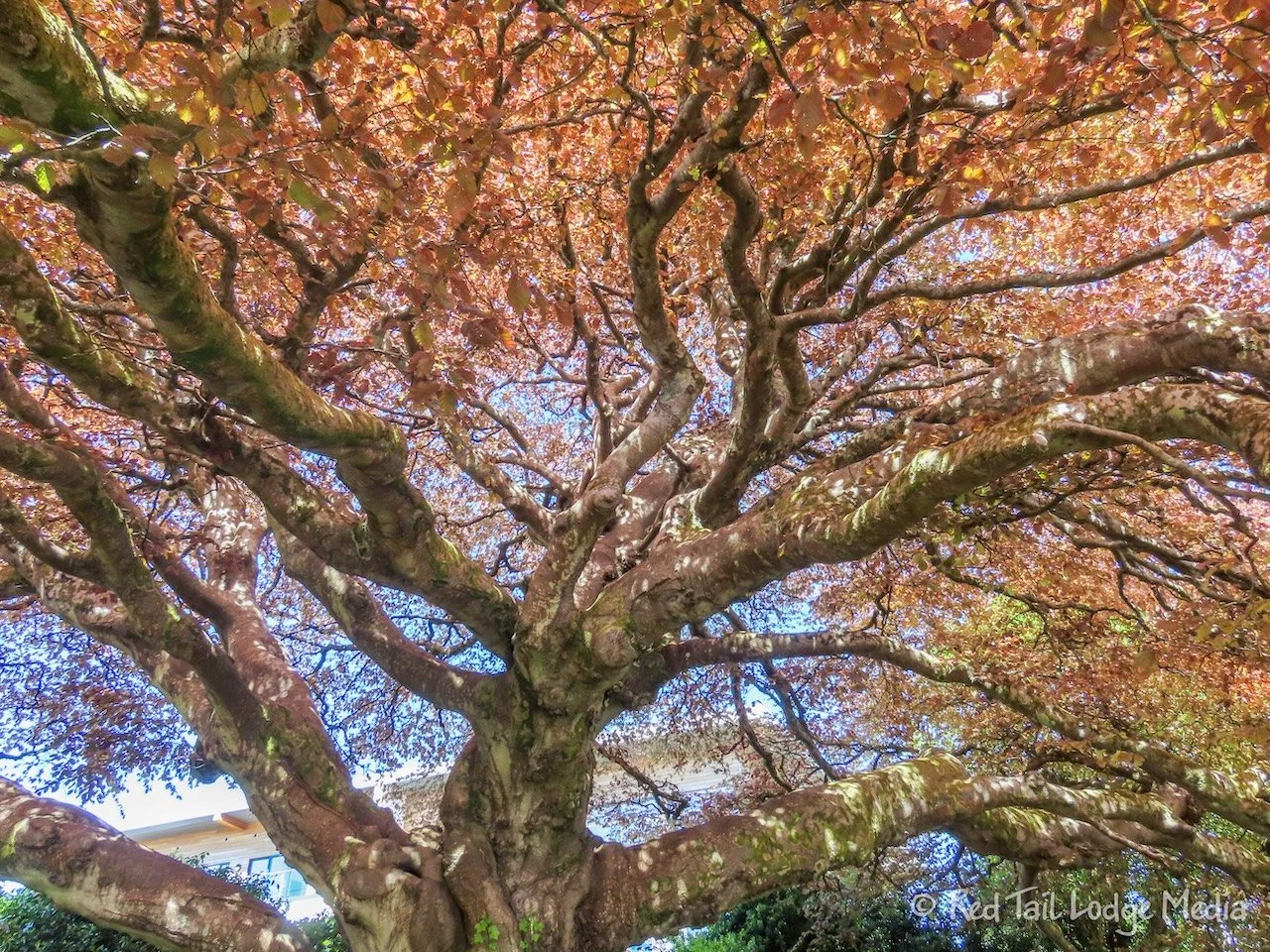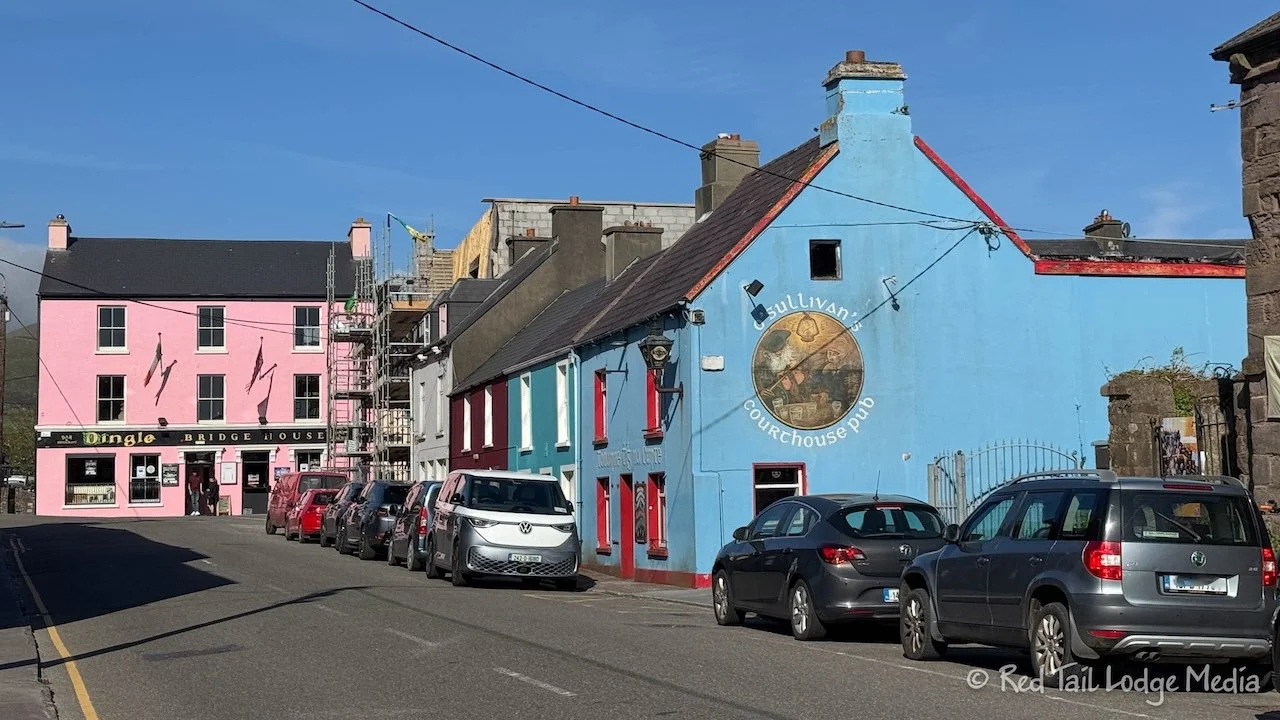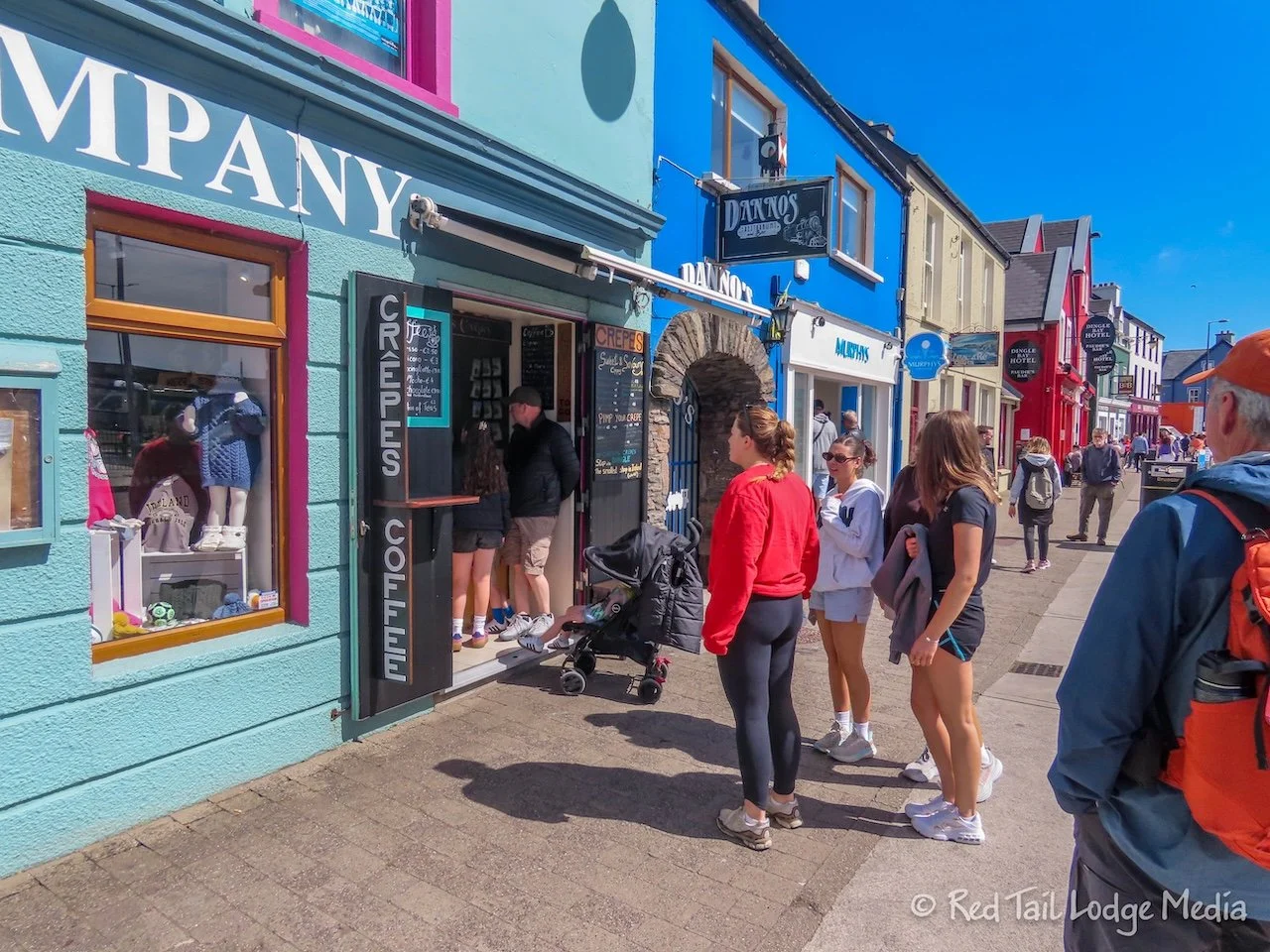Dingle, Ireland - May 2nd to 6th, 2025
The town of Dingle sits on a little bay on the Dingle Peninsula. It is a cute, small village of 1000 to 2000 people, but it has a lively music scene. The Slea Head scenic drive, which loops the peninsula, starts and ends in Dingle. The area has a nice mix of charm, music, history, and beautiful scenery.
Friday we drove from Portmagee to Dingle, both in Ireland. It was another sunny day, but cool again, with the high temperature around 15 degrees Celsius (59 degrees Fahrenheit). We only made one stop along the way.
The route we took started out on Valentia Island. We checked out the tetrapod tracks on the north side of the island. Tetrapods are the earliest known land-going vertebrates. The footprints on Valentia are one of three sites with tetrapod prints. The other two are in Australia and Poland.
We found it hard to make out the trackways, but the scenery along the coast there was beautiful, which made the stop even more worthwhile.
From Knight’s Town on the eastern tip of Valentia Island, we took the ferry across, back to the mainland. It was only about a five to ten minute ride and cost 12 euros. Just like most things in Europe, they accepted contactless payment, very handy.
Back on the mainland, we rejoined the Ring of Kerry scenic drive. This took us up to Killorgin, where we turned off of the Ring of Kerry to continue on to Dingle. It took us about two hours of nice scenery to reach Dingle.
We arrived at Bambury Guesthouse around 12:30 pm. We knew it was too early to check in, but we just wanted to leave our car parked there and walk into town. However, when we walked in to let them know we were leaving our car there, they let us check in early and drop our bags off in the room, even though they weren’t finished cleaning the room yet.
We heard there was a market in Dingle on Fridays, so our plan was to eat lunch at the market. However, the market turned out to be rather small and selling only crafts. It was not a farmer’s market. So we had lunch at Murphy’s Pub instead. Ann had a BBQ chicken panini with coleslaw while Keith ate the pulled ham toasty. Both sandwiches came with fries. All the food was tasty.
Then we strolled around town. We ventured over to the Dingle Marina to see where we were to catch our boat tour on Saturday. Keith was relieved to see the boat we would be on, because we saw a smaller boat also operated by Dingle Boat Tours that he would not have been comfortable on. He’s not a big fan of being out on the water, but he tolerates it for Ann. She is very grateful.
As we wandered around town, we got some errands done as well. A corn removal kit from the pharmacy, a short USB cable for the car, and smaller change from a bank for tips and small attractions completed our list. We also stopped by Murphy’s Ice Cream for ice cream cones. It was good ice cream, handcrafted in Dingle. Keith paired his Dingle Sea Salt scoop with a scoop of Honeycomb Caramel while Ann paired her Sea Salt with Smooth Chocolate. They had some interesting flavors, such as Irish Brown Bread, Lemon Curd, Chocolate Whiskey, and Dingle Stout.
We also scoped out the pubs for when they had trad music (traditional Irish music) playing that evening. The Dingle Pub started at 6 pm, so we settled on that one for dinner. After relaxing back at the guest house, we headed over to Dingle Pub around 5:30 pm.
For dinner, Ann had the nachos while Keith had bangers and mash (sausages and mashed potatoes). The nachos in Ireland are a little different than what we would get in the States. Instead of everything piled up on top of tortilla chips, everything was served separately. The chips, sour cream, guacamole, and salsa were each in their own containers. Then there was a bowl of a spicy beef and bean mixture with a thick layer of cheese melted on top. It was all pretty tasty. However, the guacamole tasted rather different. Ann couldn’t quite put a finger on the difference as there was a flavor to it that she couldn’t identify. We washed our food down with ginger beer.
After filling up with food, we ordered drinks. Keith started out with a pint of Dingle Red Ale while Ann had a Rockshore Cider. Then we waited for the music to begin. There was nothing at 6 pm. Close to 6:30 pm, a duo showed up and started setting up, but they didn’t start playing until 7 pm. Ann sipped her cider slowly. Keith ordered a pint of Guinness. It turns out we read the sign out front wrong, the sign said 6:30 pm, but they were still a half hour late starting.
The band was pretty good. One sang and played an acoustic guitar while the other played a flute and sometimes an Irish whistle (tin or penny whistle). The flute player was excellent. We managed to make our drinks last until about 7:45 pm, enjoying the music for 45 minutes, then we gave up our seats and headed back to the guest house.
Saturday we had a boat tour reserved, the three hour Blasket Island Eco Tour by Dingle Boat Tours. The tour wasn’t until 2 pm, so we hung out in the sitting room of the Bambury Guest House in the morning. Our room had nice views of the surrounding hillsides, Dingle Bay, and the Eask Tower. The tower sits on top of a hill. It is solid stone, built in 1847, to guide ships into Dingle Bay. Even though the views were nice from our room, the seating was more comfortable down in the sitting room on the ground floor.
For lunch, we strolled into town and picked up crepes from a little store along Slea Head Drive called McCarthy’s Crepes. We both had the lemon with butter and sugar. There was no seating at the crêperie, but there were picnic tables across the street, so we ate there.
The tour boat was larger than the one we had in Portmagee (Portmagee & Skellig, Ireland - April 29th to May 1st, 2025), so it was a smoother ride. Keith took some dramamine, but he probably didn’t need it. It was another sunny day in Ireland. We know, it’s hard to believe we’ve had so many sunny days. The sea was relatively calm again. However, it was cool, in the low teens Celsius (50’s Fahrenheit), so we had to bundle up while on the boat, especially when we were not sitting in the sun. Ann even put her gloves on.
Thankfully, we didn’t get as wet as we did on the Portmagee boat ride. We were sitting in the back on the starboard side. There was a little water running across the floor and Ann had a light, misty spray on her one side.
The boat tour was wonderful, even though we could only hear about half of what our tour guide was saying. The guide was amplified over speakers, but we were in the back, near the motors. The scenery along the shore line was spectacular.
Then we reached the tip of the Dingle peninsula and the Great Blasket Island. There was a colony of seals on the beach of Blasket Island. The island was home to a small fishing village before being abandoned in 1954.
In addition to the ruins of houses, some of the houses have been restored. You can now rent accommodations on the island in the summer and two caretakers live on the island in the summer to manage the rental accommodations and the cafe, with no electricity nor hot water.
On the ride back from the Great Blasket Island, the boat swung out away from Dingle Peninsula, in hopes of seeing some wildlife, like dolphins or whales, but we didn’t spot anything. Even without the wildlife sightings, it was a great tour.
We arrived back in Dingle right at 5 pm. After walking back to the guesthouse to drop off some of our gear, we headed out for dinner. The Fish Box sounded like a great place, but when we arrived there, close to 6 pm, there was a 45 minute wait for a table. Instead, we walked around the block to Little Italy, down a less crowded street, and were seated right away.
It was a Saturday evening and the town was hopping. It was May Day weekend, a bank holiday, along with the Feile Na Bealtaine (Feel May), a music and arts festival. Hopefully, the crowds will die down on Sunday or Monday. There were some free exhibitions around town, mostly the art displays. Most of the music events charged admission. We were mainly looking for trad music, so we bought tickets for a concert on Monday afternoon at St. James Church.
For dinner, Keith ordered the carbonara while Ann had the arrabbiata. Arrabbiata reminds us of our time living in Germany, between 1989 and 1991. Once a week in the summer, we would spend an evening playing softball in a park with other Americans. Afterwards, we would all go to an Italian restaurant called Sorrentos, in the town of Sindelfingen. Ann would usually order the arrabbiata. The restaurant owner always seemed excited that he could serve us spicy dishes, as not many Germans wanted that much spice.
For dessert at Little Italy, we both had the tiramisu. It was wonderful and cooled down Ann’s mouth from her spicy main dish. Then we went searching for trad music.
We ended up back at the Dingle Pub. It was about 7 pm and the music was already playing. It was another duo, but this time one played the concertina while the other played an acoustic guitar. And yet again, the musicians were fantastic.
We drank a Guinness and Rockshore Cider while we listened to the great music and watched a hurling match on the TV. The match was Limerick vs. Waterford. We tried to figure out how hurling was played, but we still can’t tell you exactly what the rules are. Limerick won with a score of 0-28 to 0-22. There are two ways to score. If you get the ball through the uprights, you score one point. If you can get the ball into the lower goal (similar to a soccer goal), then you get three points. But they keep the two types of scoring separate. So if a team has a score of 3-2, that is a total score of 11 (3 times 3 plus 2 times 1).
Sunday, we drove the Slea Head Drive Loop. We left the guesthouse a little bit after breakfast, around 10 am. Starting out, we tried to stop at all of the points of interest.
Our first stop was the Ogham Stones. We could make out markings on the Ogham Stones. The seven stones were moved to their current location in the mid 1800’s. Ogham is an early medieval alphabet used to write the early Irish language. Most of the inscriptions on stones are personal names or reference various trees and plants. The inscriptions date anywhere from the 4th to 9th centuries. There are roughly 400 surviving inscriptions on stone monuments throughout Ireland.
Next we went to the Fairy Fort Ringfort. This ring fort was not excavated, but you can still make out the form of it. However, the main attraction, especially for the kids, was all the farm animals. The fort is on private land, so there is a 2.50 euro charge per person. The admission includes a small container of animal feed, which attracts all the animals to the people. There are sheep, lambs, goats, llamas, pigs, horses, and ponies. It was a very entertaining stop.
Not far down the road is the Dunbeg Fort. The fort is on the edge of a cliff overlooking the ocean. It was built during the Iron Age. Parts of the fort have been lost to the sea as the cliff erodes. The little booth at the trailhead leading to the fort only accepts cash for the 3.50 euro admission fee, but there is a store and cafe on the other side of the road that will take credit cards for the tickets. The ticket includes a 12 minute film shown inside the store. It was a very worthwhile video, which included not only information about the Dunbeg Fort, but also information on the other historical sites on the peninsula.
Next was the Beehive Hut (clochán), and another admission charge. This time it was 4 euros per person and they took credit cards. The fort and huts were excavated and in good condition. We were surprised by how flat the roof was on the beehive hut that was still fully intact. It is amazing that these dry stone structures have stood up so well.
A little further down the road was Cashel Murphy. Again, another place with an admission. They took credit cards, but added another euro onto the 3 euro fee for cards. So we paid 3 euros in cash for each of us. Cashel Murphy is a prehistoric settlement. Parts of it date back to 3200 BC with the beehive huts that came later around 500 BC. The settlement is in an egg shape. In the spring and fall, the sun lights up a stone at the back of a tunnel.
Then there were more beehive huts (clochán) and, yes, more fees. The farm containing the huts also had lambs you could hold, but if that is what you are looking for, we would recommend the Fairy Fort Ringfort over this one for animals. They accepted credit cards and the fee was 4 euros per person. The intact clochán here had more of a domed roof than the flatter one we saw at the first Beehive Hut.
Our next stop was at the parking lot for Dunmore Head. Parking at the trailhead was tight, and we were lucky to get a spot. When we left, people were hovering for people to leave. Keith does not enjoy driving in these conditions, with lots of starts and stops, dealing with traffic and lots of people. Before we walked out to the view point, we split a Flapjack bar that we had with us, because Keith was hangry.
To walk out to the end of the trail and back was about 2.5 kilometers (1.6 miles). The views from the end of the trail are spectacular. The cliffs and point consist of jagged rocks, with views across a couple of pointy small islands to the Great Blasket Island. This was a filming location for Star Wars: The Last Jedi, where Rey spots Luke’s X-wing fighter in the water. But even without that claim to fame, it is a stunning view. A cash box asked for one euro per person to walk the trail.
Our last stop for the day was at the Blasket Centre. Before checking out the exhibits or the film, we headed straight for the café. It was 2 pm and we were more than ready for lunch. The food at the café was pretty decent. Keith had the cheese sandwich while Ann had the chicken sandwich. They both came with a small salad.
The admission fee for the Blasket Centre was 4 euros for seniors, but it was well worth the price. The center explains the history and the culture of the people who once inhabited the village on the Great Blasket Island. Because of their isolation from the mainland, they were one of the few remaining communities who still spoke Irish in the 18th century. There was a revival of the Irish language at the end of the 19th century.
Unfortunately, as more of the younger generations on the Great Blasket Island decided to emigrate off the island, the community could no longer sustain itself and the island was abandoned in 1954. Many of the Blasket Island people immigrated to Springfield, Massachusetts.
The Blasket Centre is only about half way around the Slea Head Drive loop, but we were done for the day. We drove back to Dingle with no other stops. We’ll finish the Slea Head Drive another day.
For dinner, we walked into town to try the Fish Box again. We thought we would have a better shot since it was only 5 pm. Again, it was about a 40 minute wait for a table. However, they had two seats available at the counter by the front window, so we took them.
Keith ordered the fish and chips while Ann went the American route, a smash burger with fries. The smash burger even had American bacon on it. It was probably the most American meal she’s had since we arrived in Europe. Both our meals were pretty good.
After dinner we went over to the Dingle Pub for music, for the third evening in a row. This time the band consisted of an accordion player, a fiddler, and an acoustic guitar player who also sang. A person joined them who played an Irish whistle. The musicians were good, but we thought the ones the previous two nights were better.
Monday we stayed close to town. In the morning, we hiked the Dingle Lighthouse Trail right from Bambury Guesthouse. The trail follows the coastline out past Hussy’s Folly and past the Dingle Lighthouse. It continues along the scenic cliffs to the mouth of Dingle Bay. Hussy’s Folly was built in 1845 for no real purpose and now lays in ruins.
By the time we returned to the guesthouse, we had covered 8.7 kilometers (5.4 miles) with an elevation gain of 119 meters (390 feet). It was hike number 12 of our 52 Hike Challenge for 2025.
For lunch, we walked into town to the Strand House Café. It is on the first floor (the American 2nd floor) of a clothing store. They have their own bakery, so the breads and pastries are wonderful.
Keith had the carrot and coriander soup while Ann had the chicken toastie with two salads. One of the salads was red cabbage with sweet bell peppers while the other was cucumber and tomatoes. They looked wonderful, but both salads were undressed, as is typical in traditional British and Irish meals. Being an American, Ann thought the salads would have been tastier with a dressing of some sort, even just a little oil and vinegar.
For dessert, Ann had the carrot cake while Keith had an orange and almond cake. They were delicious.
From there, we walked over to An Diseart Gardens. We were hoping to catch some of the open trad session. The session started at noon, but it was getting close to 1:30 pm. On our way there, a lot of people were walking the opposite direction. Did the session just end? Yup.
We went and sat down at picnic table in the gardens anyway. We had tickets for a 3 pm concert in St. James Church, so we had over an hour to kill. The gardens were peaceful, with birds chirping, and families relaxing on blankets in the grass. It was another beautiful sunny warm day and everyone wanted to enjoy it. While we were sitting there, a fiddle player softly played a song or two before leaving.
The concert was part of the Feile Na Bealtaine festival, but St. James Church normally hosts music concerts every Monday, Wednesday, and Friday. The concert this time was Tom Delany and his band. Tom Delany is internationally known for his uilleann pipes (Irish bagpipes) playing. His band that day consisted of a concertina player, a cello player, an acoustic guitar player, and a bouzouki player. The Irish bouzouki is derived from the Greek bouzouki, added to traditional Irish music in the mid 1960’s. It is a long necked lute, similar in appearance to a guitar.
The music was superb. Tom played three different sets of pipes along with a whistle. The music was a nice variety of reels, jigs, and slow airs. The concert was over an hour long and it went by quickly, as it was very enjoyable. Yes, you heard that right. Listening to an hour of bagpipes was very enjoyable, at least when Tom Delany is playing.
For dinner, we ended up at James Long Pub. The weekend festival crowds were starting to thin out. It was only 5 pm and the tables were filling up fast at the pub. We managed to get an outside table along Slea Head Drive. Keith had the loin of pork roast while Ann chose the chicken curry.
After dinner, we stopped at Murphy’s Ice Cream for dessert. Keith got the sea salt and honeycomb caramel again while Ann paired the lemon curd with the smooth chocolate this time. We sat across the street on a bench in the park, overlooking the marina and bay, soaking in the evening sun.
Across the street from the guesthouse is a sports field. It looked like some youth teams were playing football (soccer), so we stopped to check it out. Wait a minute, they’re using their hands and picking up the ball. That’s not the European football or soccer sport that we know. It turns out that Ireland has their own version of football, called Gaelic football or just Gaelic. The ball can be kicked, punched, carried, or hand-passed. Unlike hurling, Gaelic is strictly an amateur sport. Scoring in Gaelic is similar to hurling. A point is earned by kicking or hand-passing the ball through the uprights. A goal, worth three points, is awarded when the ball is kicked into the goal below the cross bar (hand throwing is not allowed for a goal).
Tuesday, we finished up the Slea Head Drive. There were three things we skipped the first time we drove it, so we just went straight to those, heading out in the counter-clockwise direction this time.
First up was the Riasc Monastic Settlement. It is believed the site was originally inhabited in the 6th century, but they are not sure when it was abandoned. One of the pillar stones has elaborate swirled designs on it, but it was in shadow when we were there, so the inscription was hard to see. The settlement is in the Office of Public Works care, so there is no charge to visit it.
Next up was the Gallarus Oratory. It is the best preserved ancient church in Ireland. They are not certain exactly when it was built, but it is believed to be over 1000 years old. It is a dry stone building that is still waterproof. The admission fee at the visitor center is 5 euros per person and includes an audio-visual presentation.
From there, we drove over to the Tigh T.P. Bar in the small village of Murreagh. The bar was at the start of a short hike we wanted to go on. We were hoping to get some lunch there before our walk, but the bar wasn’t open yet. A local man told us that the bar wouldn’t open up until 12:30 pm and the kitchen wouldn’t be open that day. It was only 11:30 am, so we decided to go ahead with our hike without lunch. We had one flapjack energy bar left in our daypacks, so we split that half way through the hike.
The route we took was called the Ballydavid Cliff Walk in AllTrails. It followed along the rocky shoreline of Smerwick Harbour. It was a short section of the Dingle Way long distance trail. The Dingle Way is 179 km long (111 miles) with a total elevation gain of 2300 meters (7500 feet). It starts and ends in the town of Tralee, circling the Dingle peninsula. We only walked 5.3 kilometers (3.3 miles) of it, with an elevation gain of 85 metres (279 feet), which took us only an hour and 45 minutes to complete. We counted it as hike number 13 of our 52 Hike Challenge for 2025.
Our last stop on the Slea Head Drive was the Kilmalkedar Church (Cill Maoilchéadair). Kilmalkedar is a ruined 12th century Romanesque church. It has fine carvings. The location also has several older artifacts, such as a sundial from the 8th or 9th century and the Alphabet Stone from the 6th century. Like the Riasc Monastic Settlement, there is no fee for visiting Kilmalkedar.
After returning to Dingle, we went to An Cupan Tae Cafe for a late lunch. Ann had the Italian chicken panini while Keith had the bacon, brie, and cranberry toastie. Both sandwiches came with a small salad, lightly drizzled with balsamic vinegar.
We didn’t hang out long back in the room before it was time for dinner. It took us a little while to find a place to eat. Some of the places were closed on Tuesdays. Others were already booked full for the evening, even though the town was much quieter now that the festival and the bank holiday weekend was over. We tried going back to Little Italy, which supposedly was normally open on Tuesdays, but they were also closed. They were probably recovering from the busy weekend. So we ended up at Paul Geaney’s Pub.
Paul Geaney’s had a large menu with a variety of dishes not found at all pubs. Ann ordered the Chinese chicken noodles while Keith had a pizza with salami and tomatoes. The noodles were a nice change. It was a sweet and spicy dish with ginger, garlic, sweet peppers, and mushrooms.
While we were eating, a cricket match was on the TV. We tried to figure out what the rules were and how teams scored points. We weren’t very successful. It was easy to figure out that four points were scored if the ball crossed the outer boundaries of the field. If it crossed out on the fly, it was six points. The single and double scores were not very clear to us. It also seemed like the batter was out if the ball was caught in the air, or if he missed a good pitch. Other than that, we were pretty lost about the game.
After dinner, we walked across the street to Foxy John’s Pub & Hardware. Foxy John’s is both an Irish Pub and a hardware store. And yes, it still operates as a hardware store during the day. This particular evening, they had trad music starting at 6:30 pm. The band was a pair of musicians, one being a uilleann pipes player and the other an acoustic guitar player. The guitar player was the same one who played with Tom Delany at the concert the day before. His name is Tommy O’Sullivan. He, along with his wife Sandra, own the O’Sullivan’s Courthouse Pub. We didn’t visit their pub, as their music didn’t start until 9 pm, which is later than we like to stay out.
Like all the other musicians, these two at Foxy John’s were fantastic. However, there wasn’t much seating in the small front area where the music was being played, so we both stood for over an hour. After finishing our drinks, our old bodies told us it was time to go, even though we would have liked to listen to the music longer.
Dingle did not disappoint us. Even though it was crowded during the festival, that did not keep us from enjoying the village and the surrounding area. The historic sites were interesting and the scenery was gorgeous, but our favorite part was the music in the lively little pubs.
Check out our related video: Dingle, Ireland
(Ann)


